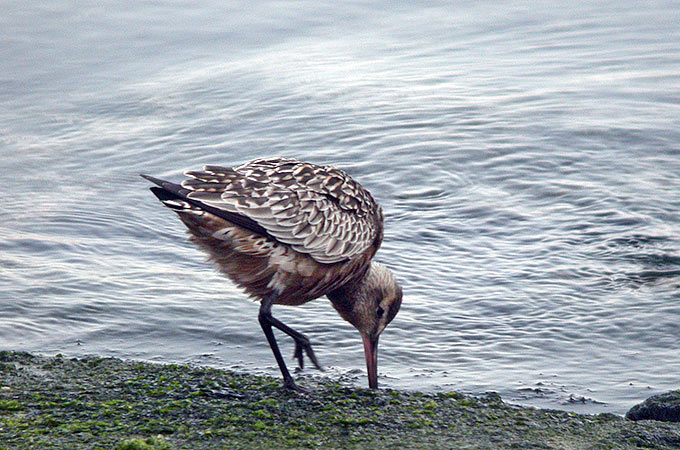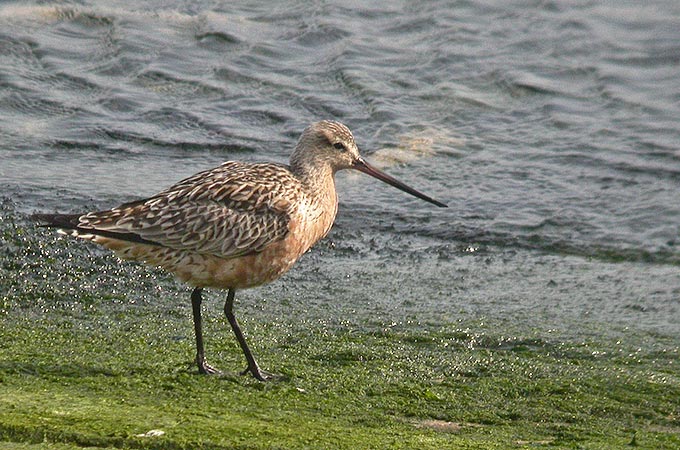 | E-mail to Birds Korea |
 | KWBS |
in the Region
 | The Oriental Bird Club |
 | BirdLife International (Asia) |
April
One of the very best birdwatching months! Cold days and nights (lowest day maxima of ca 12°C) gradually warm through the month (reaching the low 20s°C by month’s end), and dry spells interspersed with 1-2 days of heavy rain and stormy conditions produce great birding towards month’s end.
Early in the month, late Hooded Crane move through while shorebird numbers and persity start to build up. While the concentrations of 200,000 shorebirds at Saemangeum are no longer to be found since seawall close there in 2006, internationally important concentrations of species like Great Knot and the Critically Endangered Spoon-billed Sandpiper, Nordmanns’ Greenshank and the highest known concentrations of osculans “Far Eastern Oystercatcher” can still be found at the adjacent Geum Estuary. Other Korean specialties include Chinese Egret from mid-month, and Black-faced Spoonbill in small groups along the west coast. This latter species has a world population of only 1500 or 1600! While early April sees species like Brown-headed Thrush and Japanese Robin in very small numbers in the far southwest and southeast, mid-April is marked by the first large passerine arrivals and spring overshoots, with good counts possible of Blue-and-white, Narcissus and Yellow-rumped Flycatchers, and Tristram’s and Yellow-browed Buntings. Late in the month, 100 or more species a day are possible on the outer islands like Heuksan and Gageo in the far south, Eocheong off Gunsan, and Socheong in the far northwest.
In more than one recent year, highlights have included Pied Wheatear, Caspian Tern, Japanese Night Heron, Black-headed Bunting and Himalayan Swiftlet. Korean firsts for April include a Northern House Martin and Red-breasted Flycatcher on Eocheong in 2003, a Paddyfield Warbler on Hong Island in 2004, a pandoo Blue Rock Thrush in 2005, and a Claudia’s Leaf Warbler on Socheong Island in 2009.
(The following records are a compilation of our own sightings and records sent in by other observers. As well as being posted on the Birds Korea website(s), selected records are also forwarded to other Korean-language birding websites; records of threatened species are arranged and forwarded to Birdlife International and national authorities when appropriate; flag images and records are passed to bodies responsible for their coordination throughout the flyway; and all records sent to us are used to compile annual reports and to support the evolving understanding of the status of many of Korea’s birds.)
Gageo Island, April 30
Another day of Black Woodpigeon survey in good weather conditions, with other highlights being another singing Sakhalin Leaf Warbler (this time, near the peak) and a full adult male Black Paradise Flycatcher, resplendent with streamers, on the 1-Gu back trail.
Gwangmyeoung, April 30
A very fast bird on scythe-like wings, with erratic flight passed over my school this morning: a White-throated Needle-tailed Swift- first of the spring and a rare sight on the mainland.
Gageo Island, April 29
In warm sunshine and almost calm conditions for much of the day (benefit of a high pressure system reaching deep into southern China), a survey of Black Woodpigeon between 3-Gu (where several outstanding highlights), the lighthouse and 2-Gu (entailing a 12 hour hike). Reached by steep descent down a rock scree track from 440m down to sea-level, 3-Gu is likely one of the better, hard to access birding areas in the country... In addition, to c8 simplex Japanese White-eye, several Siberian Rubythroat and two Yellow Bunting, the first major highlight of the day there was a second calendar year male owstoni Narcissus Flycatcher (increasingly credited with full species status), seen well, but not photographed. Soon after, a Sakhalin Leaf Warbler was heard singing in the main grove by the stream, and one song phrase was recorded. What is believed to be the same bird, much paler than typical Pale-legged, was then photographed in the same spot. Two km north, still in 3-gu!, the third and most exceptional highlight of the day was a cuckoo singing with a four-note phrase, "Huk-Poo-Poo-Poo": Himalayan Cuckoo Cuculus saturatus. Although heard singing very distantly at first, it suddenly sang two or three phrases within 100 m - unfortunately too briefly to secure a recording. It was then heard singing a very short time later very distantly to the north (and again not recorded), but could not be refound. There appears to be no accepted/properly documented national record to date of this newly recognised species, split from Oriental Cuckoo, even though it is mapped in Birds of East Asia as occuring within a few hundred kilometers of Korea. Other species of note for the day include 10 murrelet sp off the lighthouse, and the personal first Chinese Sparrowhawk of the spring.

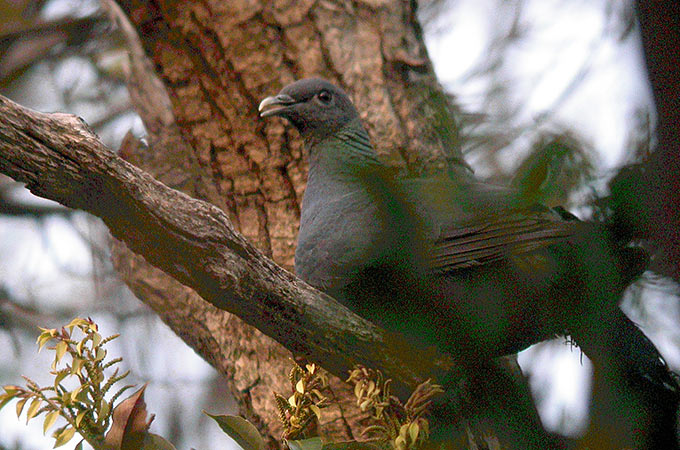
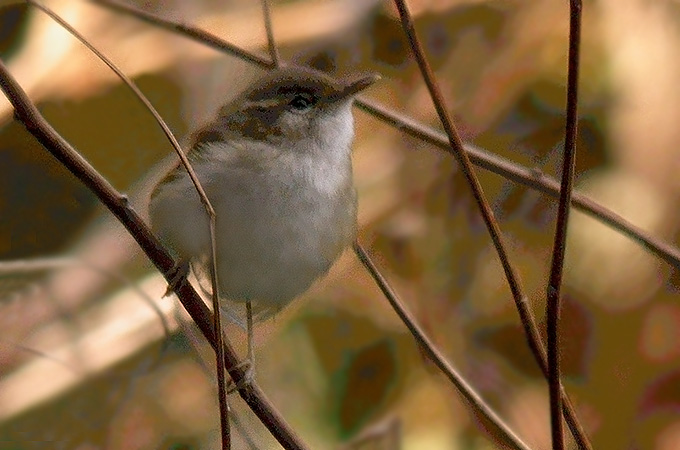

Listen to the recording of the Sakhalin Leaf Warbler:
Presumed Sakhalin Leaf Warbler sound
Ganghwa Do, April 29
Ganghwa Do is currently undergoing an extensive makeover, in various hot-spots, to appear more tourist friendly. At Jeungdong Sa, around the construction of a mini "Korean Folk Village", I saw good numbers of Dusky & Eastern Crowned Warbler, 6 Hawfinch, 2 Ashy Minivet, 2 Great Spotted Woodpecker, 1 Tristam's Bunting, 4 Dusky Thrush, and 1 Red-Flanked Bluetail. Along the road to the Family Waterpark, very close to the new 'Superhighway', I encountered the following: 2 Barn Swallow, 4 Common Sandpiper, 10 Marsh Sandpiper, 6 Green Sandpiper, 1 Wood Sandpiper, 12 Black Faced Bunting, 1 Chinese Pond Heron, 15 Common Snipe, and a very odd Ruddy Shelduck that looked dazed and confused.
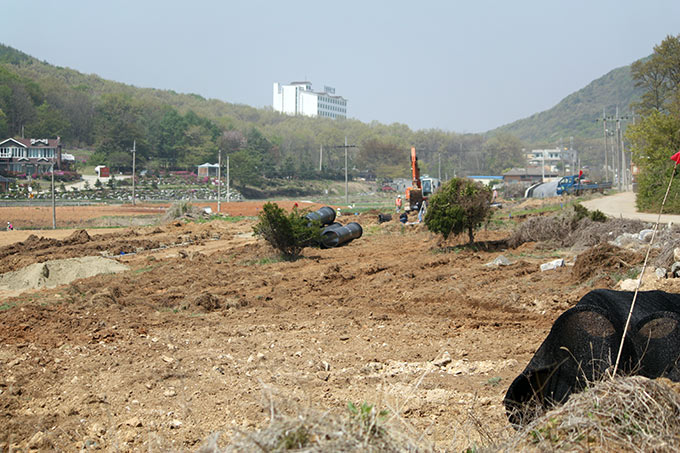
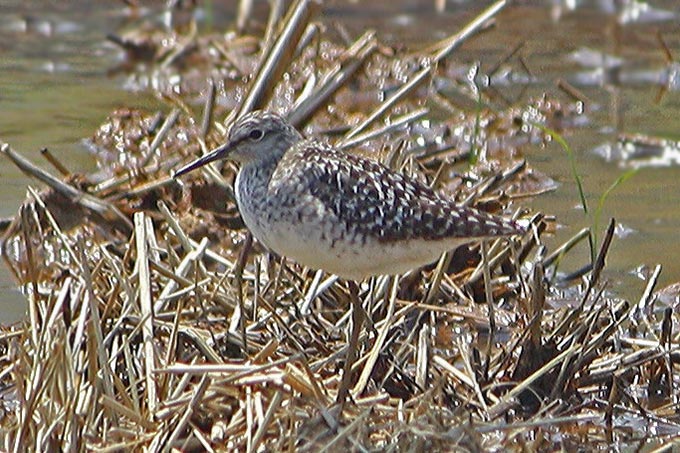
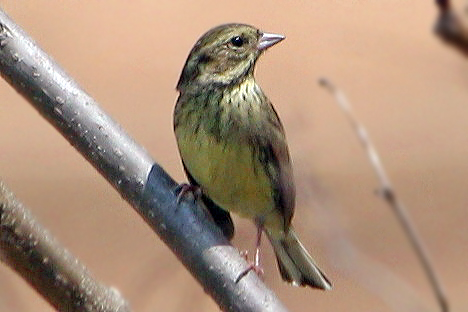
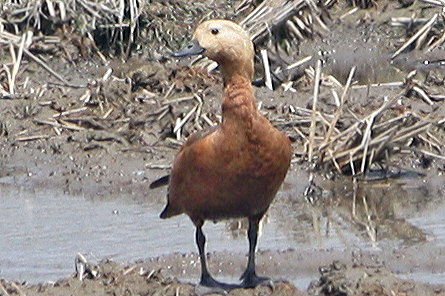
Gageo Island, April 28
In warm sunshine with light south-westerlies, only 3.5 hours in the field, counting along the Il-Gu circuit. Despite the short time spent surveying, still 97 species logged, including three crooning Black Woodpigeon, more than a dozen species of shorebird (with even the "stream" hosting both Wood and Marsh Sandpipers and a Common Greenshank), increased numbers of Little Bunting (35) and Yellow-browed Warbler (25), another or one of the same Northern House Martins from 2 days before, and the personal first Black-capped Kingfisher, (oddly-singing) Indian Cuckoo and Daurian Starling of the spring. Highlight was again a Large Hawk-cuckoo. This one glided past at close range in the gully behind the minbak, and looked obviously darker and browner-headed than the bird of a few days before: the third one in a week?
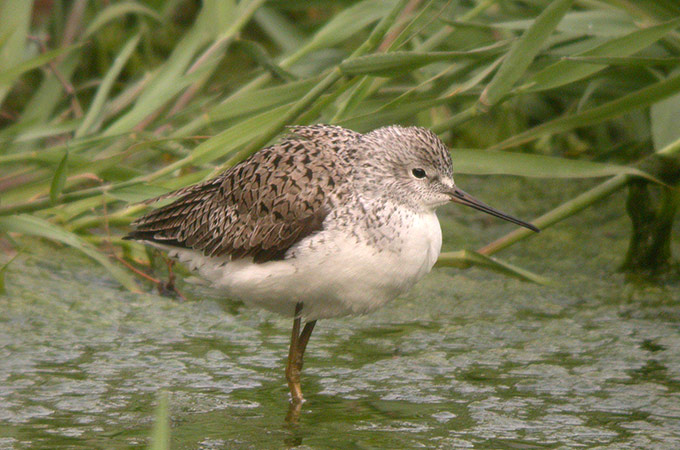
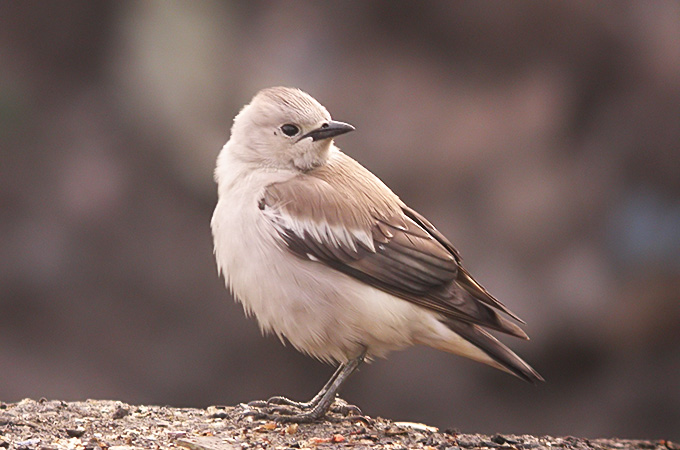
Gageo-do and ferry to Mokpo, April 27
A supplement to Nial Moores’ report of the same date. The few hours before the boat included views of the shorebird collection at the harbor, with especially good views of Wood Sandpiper, the two Curlew Sandpipers, Red-necked Stints, and the Common Redshank; a single Brown Shrike in the bamboo grove, Narcissus and Blue and White Flycatchers, a calling Yellow-browed Warbler, the White-breasted Waterhen and the Red-billed Starling. The ferry returned over somewhat rough seas; highlights were a few distant (unidentified) Loons, an equally distant presumed (from structure and esp. flight action) dark phase Pomarine Jaeger, and a small flock of 15 Northern Phalaropes.
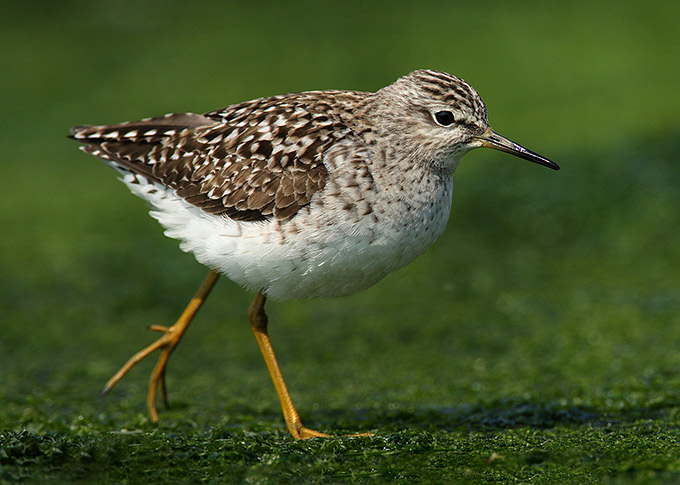
Gageo Island, April 27
With winds now west/southwest 2-3, warmer sunshine, and Prof. Robin Newlin leaving the island in the morning, most of the day was spent at or towards 2-Gu, monitoring migrants and watching Black Woodpigeons.IIn total, at least 98 species logged during the day, with species of note including 4 Green Sandpiper and a Common Redshank on the beach (joining now 4 Common Greenshank, seven Marsh Sandpiper and a dozen other shorebird species), two Little Whimbrel at the Pass, and probably another in the quarry, and the personal first Black-naped Oriole and Grey Nightjar of the spring. In addition to observing territorial disputes between pairs of Black Woodpigeon (which still remained very well-hidden in the canopy, in between bouts of chasing and crashing through the foliage), a singing menzbieri Pechora Pipit and a close encounter with a Siberian Rubythroat, there were also at least two Chinese Blackbird, a Hume’s Leaf Warbler, at least five Light-vented Bulbul, a probably new Northern House Martin (at 2-Gu) and the Red-breasted Flycatcher again, reappearing after a day’s absence. Remarkably, all five of these last species were first recorded in Korea during the past ten years...
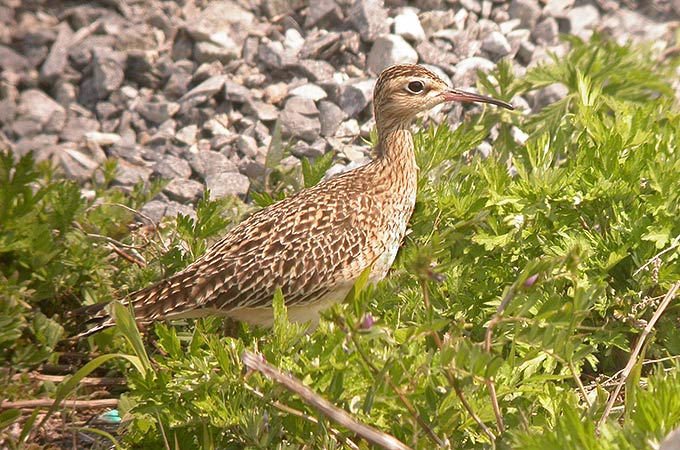
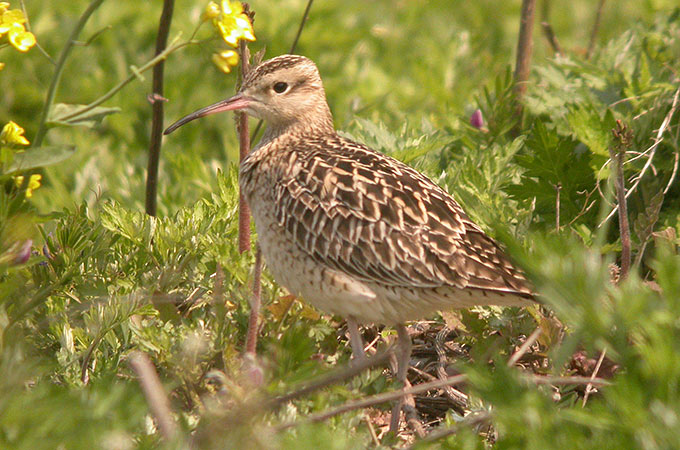
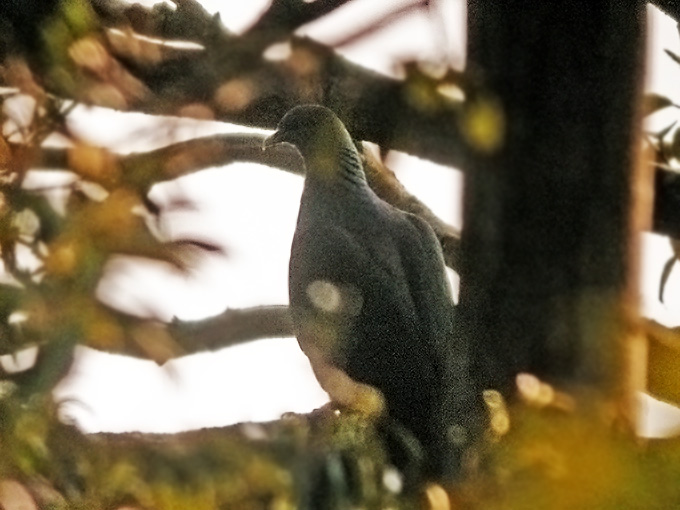
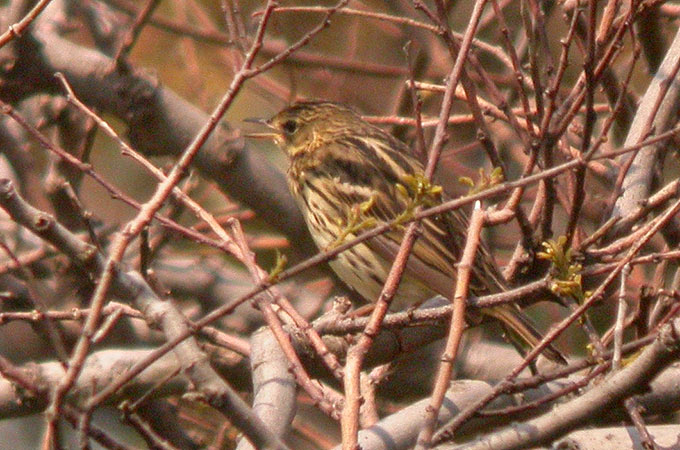
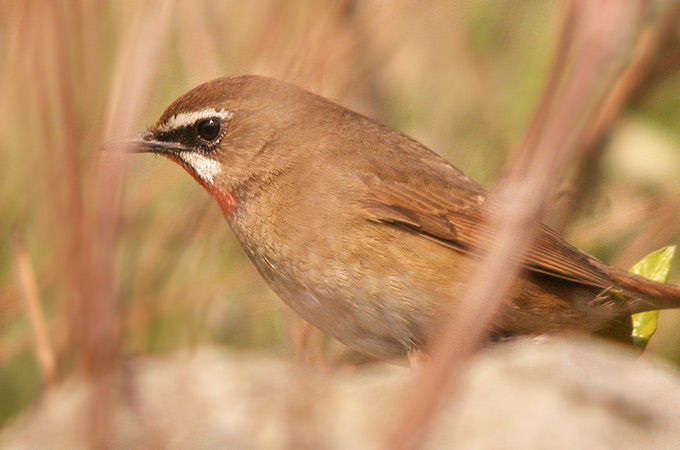
Mokpo Namhang Urban Wetland, April 26
During the daily survey work a Little Ringed Plover was found trapped with its wing in a scattered fishing net. After the rescue the bird rested for several minutes and then flew back to its partner.
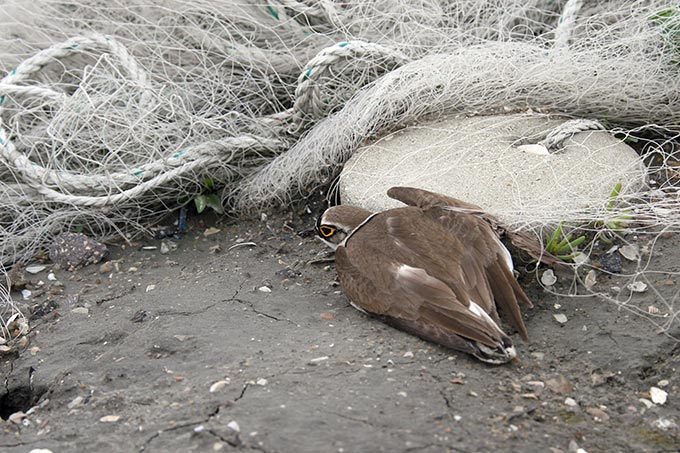
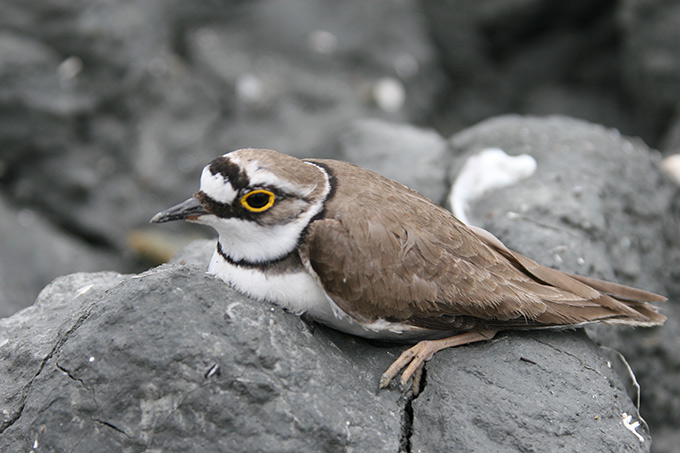
Yanggu x wetlands and farms, April 25 & 26
I had an interesting weekend of birdwatching on April 25 and 26. Saturdays weather was a bit damp and cool, but I went out in the middle of the day when the drizzle stopped for a while. It turned out to be a good idea because I saw some good birds. Along the river there were 11 Northern Shovelers, Barn Swallows, Eastern great Egrets, Little Egrets, Grey Herons, Striated Herons, Common Pheasants, Dusky Thrushes, Siberian Stonechats, Common Sandpipers, Long-billed Plovers, Little Ringed Plovers, Spot-billed Ducks, Mandarin Ducks and 3 species of Wagtails. In flooded rice fields I found 6 Black-winged Stilts, 5 Marsh Sandpipers and Common Snipe.
The weather was finer on Sunday so I was out birdwatching again. There were many people working on the rice farms, with the first rice being planted, particularly in the rice paddy where I saw the Stilts. Never the less, it was worth making the effort to go out again. Among the birds I saw were 3 Red-rumped Swallows, several Black-faced Buntings, 9 Common Snipe, a White-breasted Waterhen and an Eastern Great Egret with red legs. Wagtails included Japanese, Grey and White, the latter represented by 2 subspecies, Motacilla alba leucopsis and M. a. ocularis. Of the 9 Snipe I got photos of 6 of them hiding amongst some vegetation beside the new dam. Grey Herons and Eastern Great Egrets are now breeding on a hill near the new dam, at the same site they have been using since before I came to Yanggu.
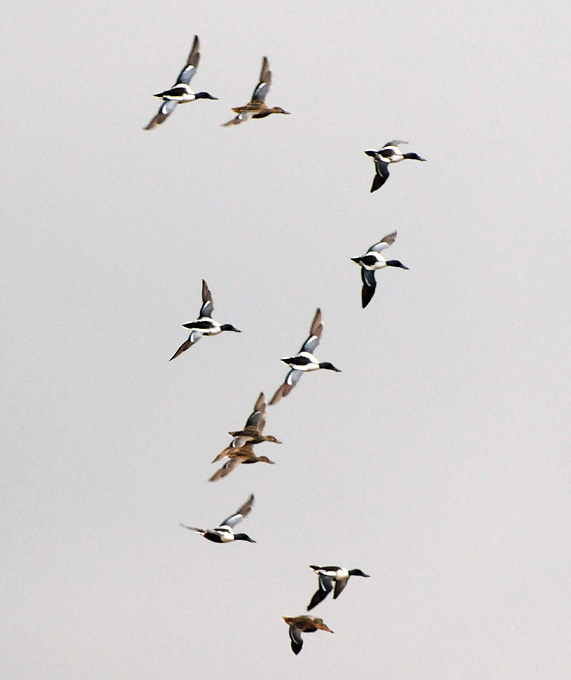
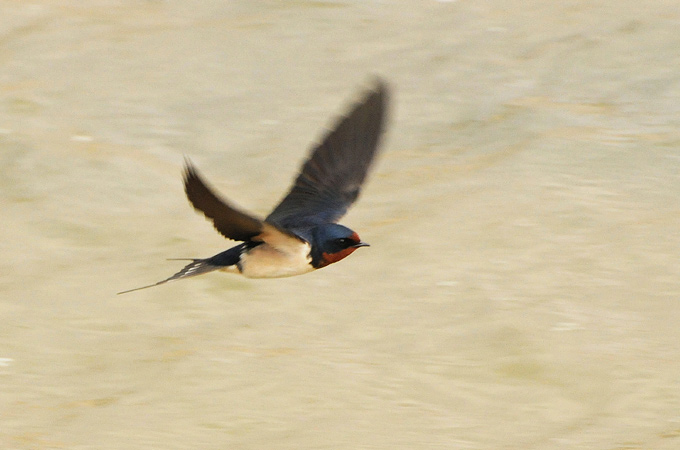
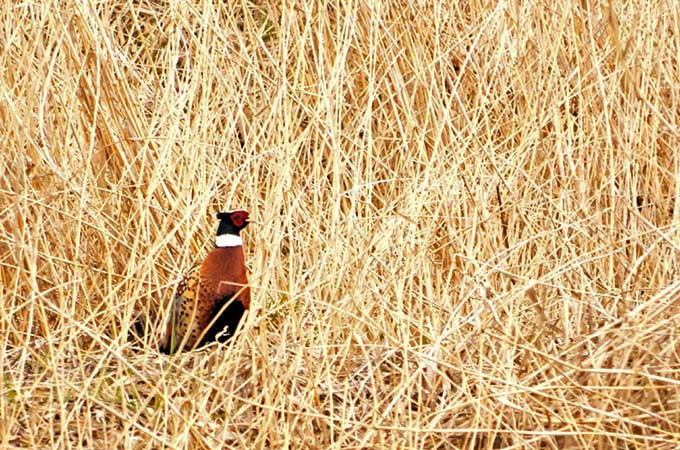
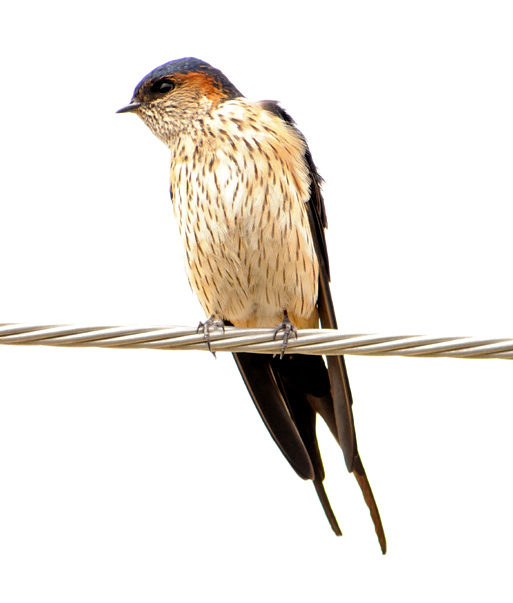
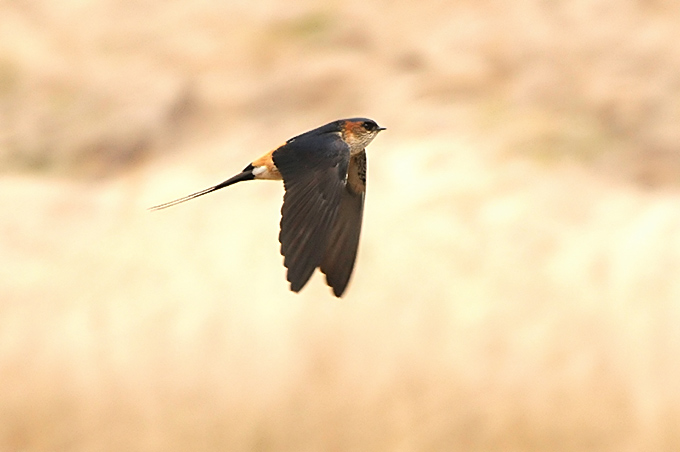
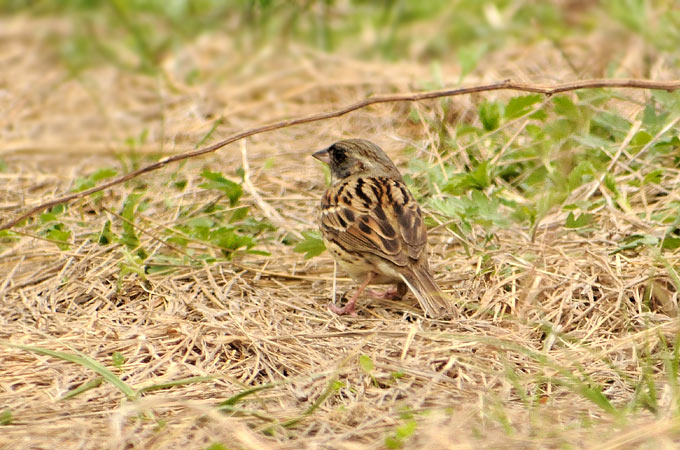
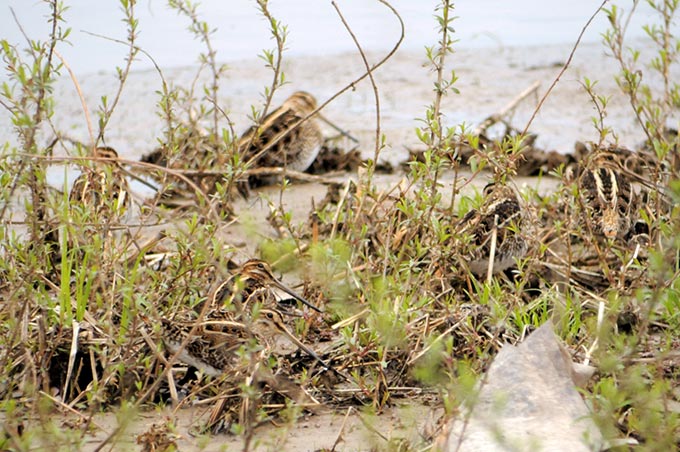
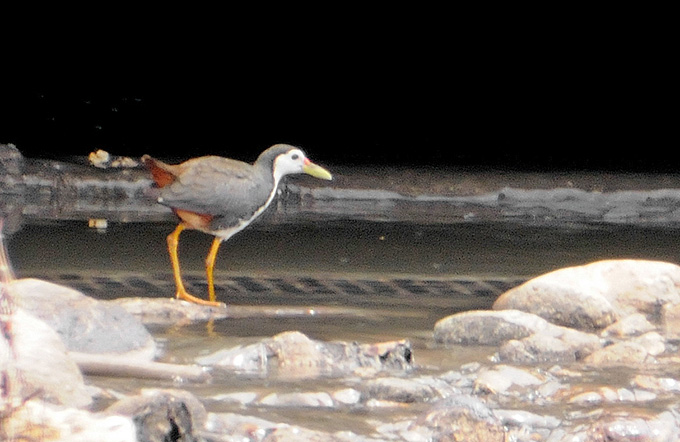
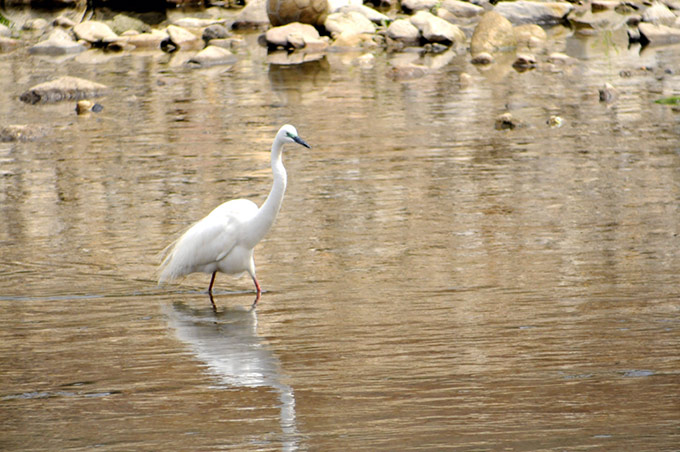
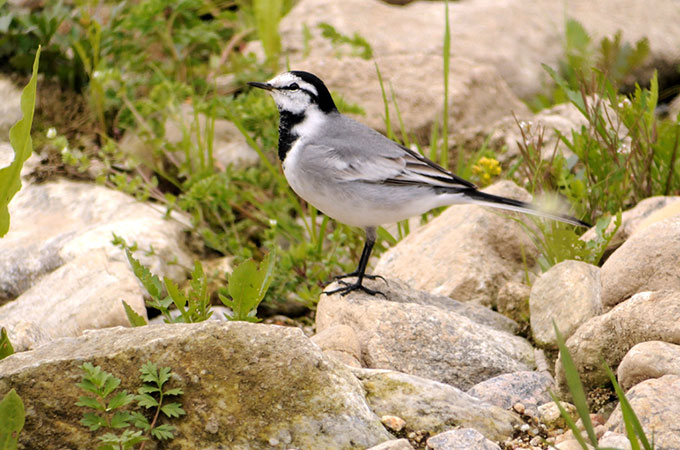
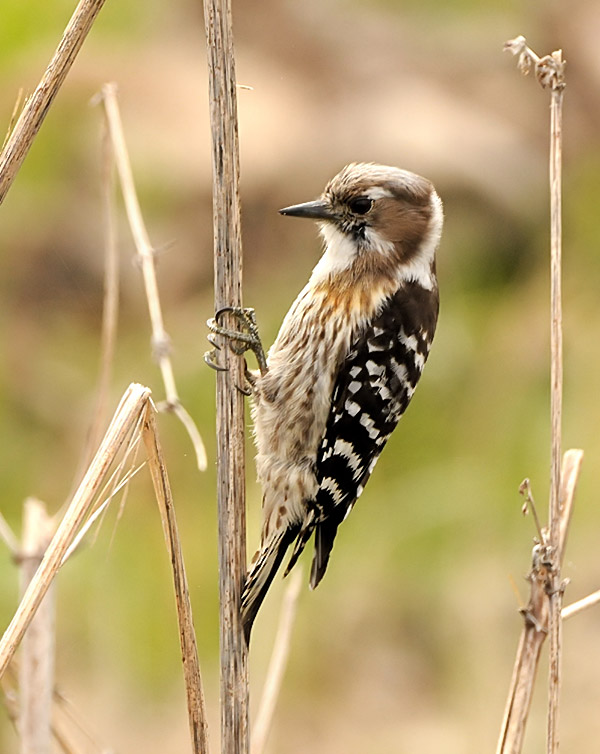
Namsan, April 26
Although the cloudy weather tried to set the tone for the day, on Namsan, the birds of spring were quite active. Along the forest floor, that escaped human clearing, were good numbers of Grey-Backed, White's, & Brown Thrush. I also managed to find 1 Eye-browed and 2 Scaly Thrush. Along the tree-tops (the only area seemingly undisturbed from relandscaping) I saw the following: 1 Pallas' Leaf Warbler, 4 Eastern Crowned Warbler, 2 Blue-and White Flycatcher, 1 Narcissus Flycatcherand 1 Common Cuckoo (seen & heard).
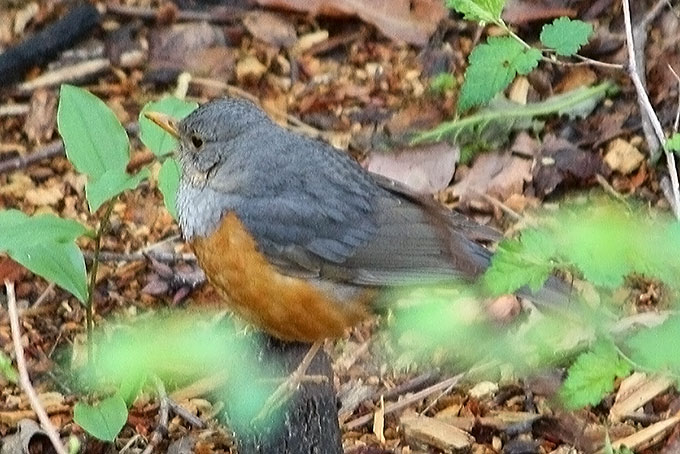
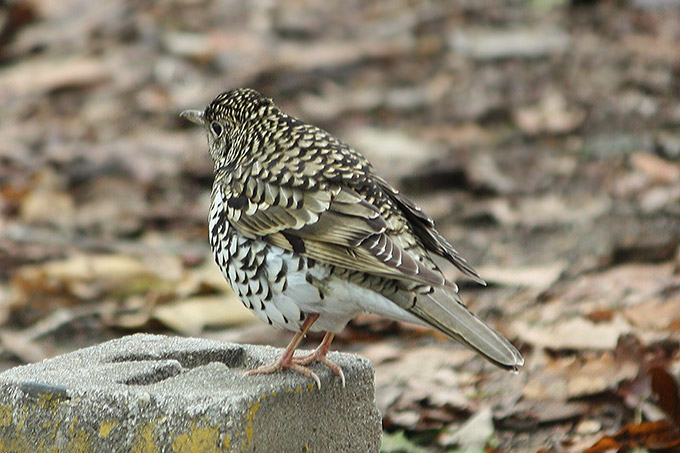
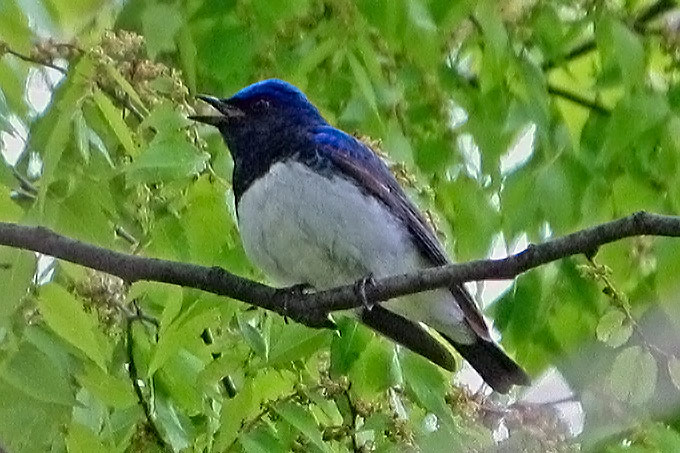
Southwest and west coast, Jeju Island, April 26
A great day of birding, thanks to Young-Ho Kim of ‘Birds in Jeju’, who showed me a dozen secluded freshwater wetland areas that aren’t readily visible from the main road. At a former Japanese airfield now used for farming, great close views of 2 Oriental Pratincole, and a Little Whimbrel got the day started well. Three Common Snipe, 8 Far Eastern Skylark, 1 Zitting Cisticola, and 2 Japanese Quail were also found in these fields.
At a nearby wetland, 12 Cattle Egret, 2 stunning Chinese Pond Heron, 6 Black-tailed Godwit, and 20 Wood Sandpiper were seen feeding close to a small road.
A small beach on the west coast held 2 Pacific Golden Plover, as well as 20 Red-necked Stint, 3 Long-toed Stint, 2 Temminck’s Stint, and a Little-ringed Plover. A Dunlin and a Marsh Sandpiper were seen in a nearby wetland. On a rocky part of the coast, about 25 Whimbrel, and a Common Greenshank.
A wetland near Gosan held 4 Black-winged Stilt, while a single Red-rumped Swallow flew low over the water in the company of clouds of Barn Swallow.

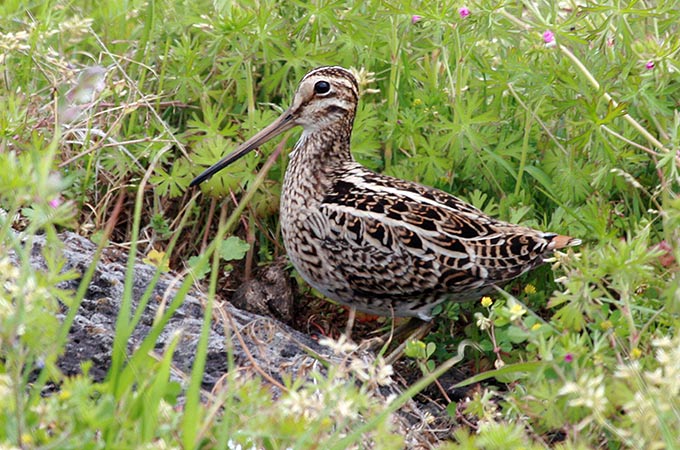
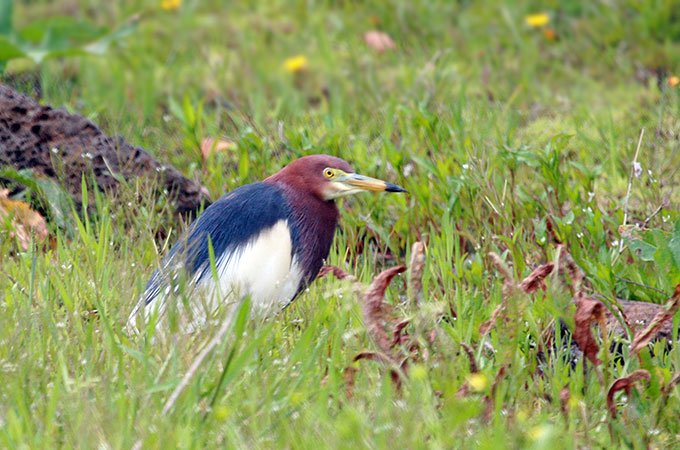
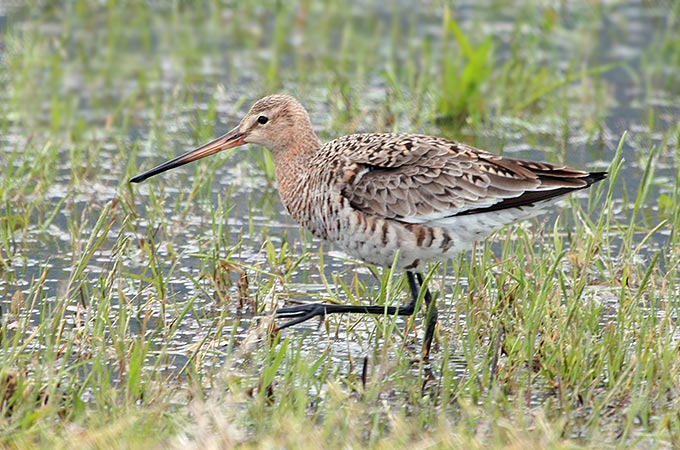
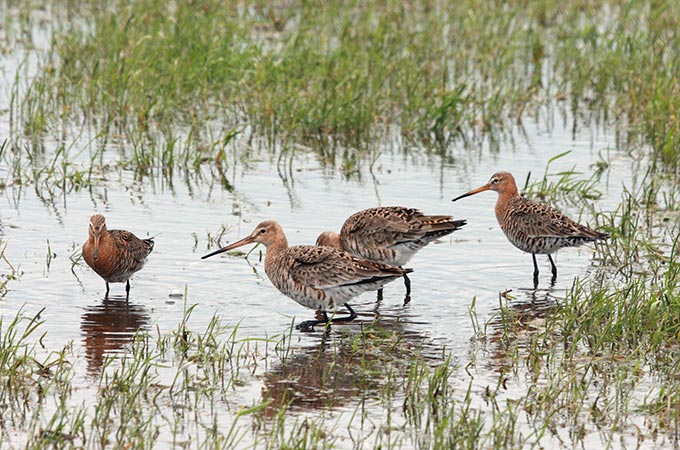
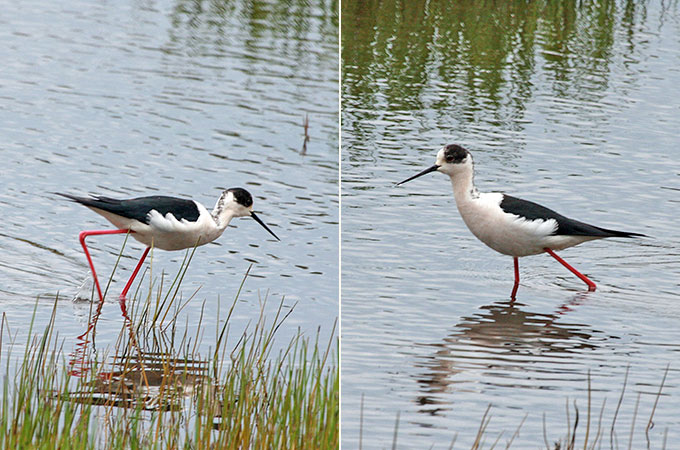
Gageo Island, April 26
Again bright and very breezy, with strong north-westerly winds throughout the day, moderating towards evening. A reduced amount of time in the field (only 3.5 hours in the afternoon) still yielded 94 species in 1-Gu, with Oriental Dollarbird and Amur Falcon (a gorgeous adult male) both personal firsts of the spring. On the “beach” still a good assortment of shorebirds, with now two Curlew Sandpiper, one Long-toed and three Red-necked Stints, single Sharp-tailed, six Marsh and four Terek Sandpipers, and now five Grey-tailed Tattler. Clearly, movement was still ongoing (reorientation after the storm?), with fewer egrets and buntings (only 4 Yellow-breasted and two Yellow in the quarry for example) but also a Little Whimbrel arriving in off the sea, small numbers of Grey-faced Buzzard moving north (at least 10) and increased numbers of hirundines, both in the air and huddled on ledges and on the ground near the rubbish tip. There, in among 80 or so Red-rumped and 40 Barn Swallow, were six Asian House and highlight of the day, two Northern House Martin.
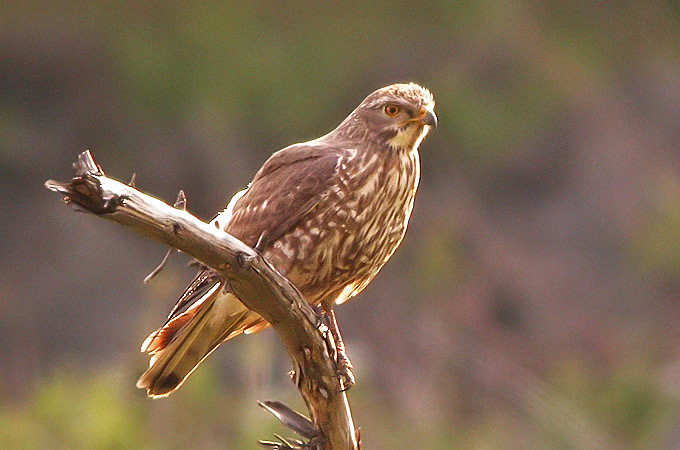

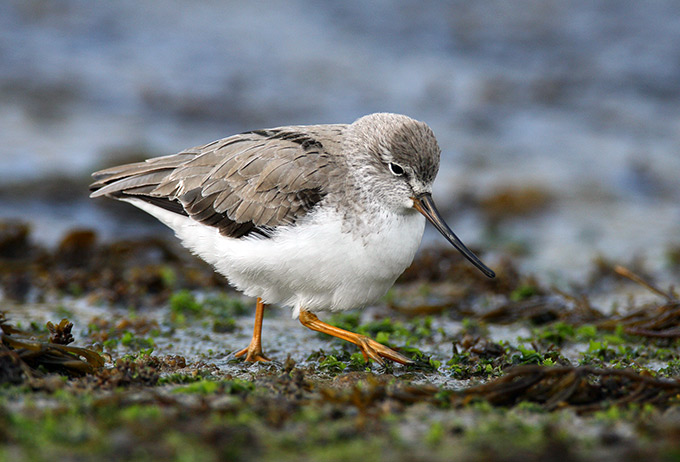


Songdo, April 26
With noisy construction continuing all around them, Black-faced Spoonbills are nesting in amongst the Mongolian Gull colony. Adults are sitting on two nests, occasionally standing to turn their eggs: their attendant partners openly thieving reed stems from the neighboring Gull nests before adding them to their own.This may be the first record of mainland breeding for this species, and may signal that they have been pushed out of preferential nest sites elsewhere. 16 individuals were noted.
On the mudflat, very distant shorebirds were pushed towards the mouth of Sorae creek- too far to count, although 2 Chinese Egret and flocks of Little Tern, Dunlin and Great Knot clearly present.The only waders to briefly drop onto the much disturbed former brackish area were 420 Whimbrel, and handfuls of Eastern Oystercatcher, Common Shelduck, Kentish Plover, and Common Greenshank. Saunders's Gulls are busy carrying and fetching for their breeding colony, which is increasingly further away from the mud, as development claims more chunks of estuary.
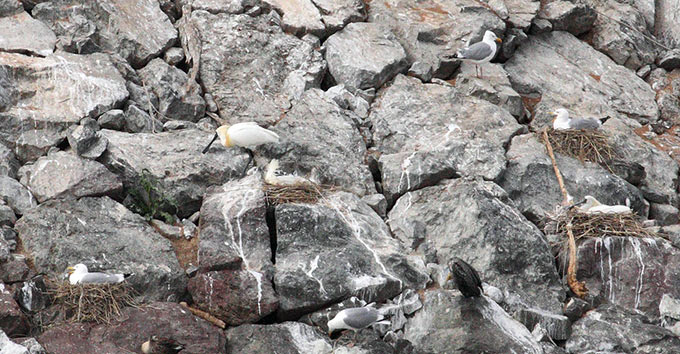
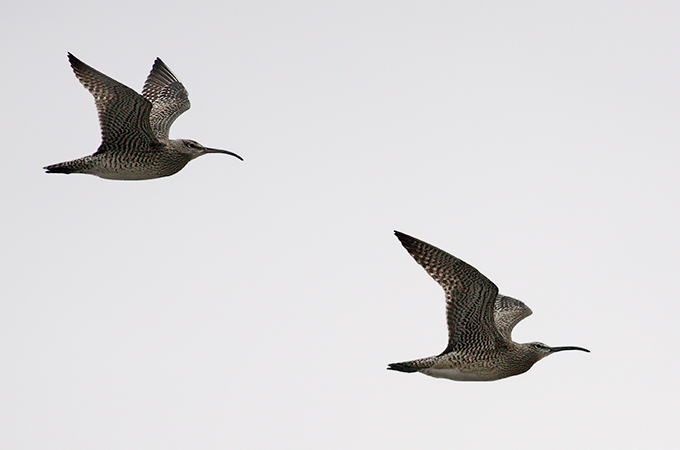
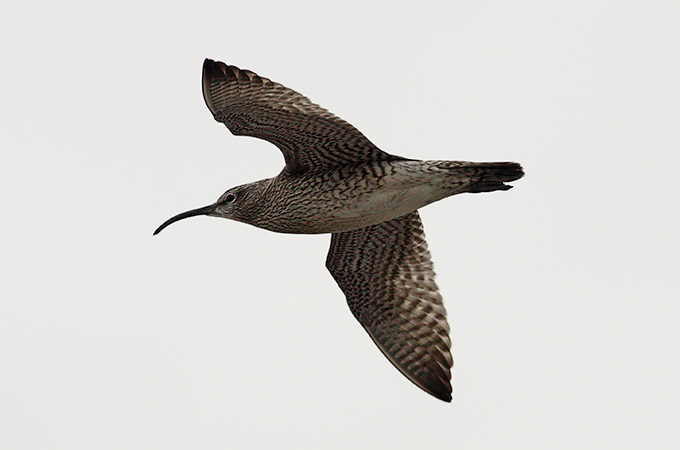
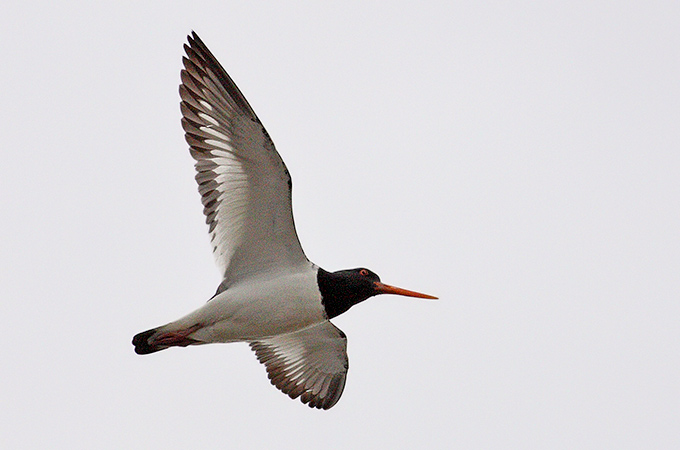
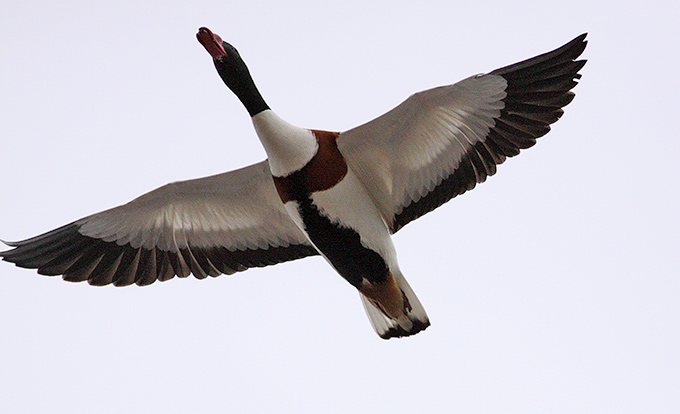
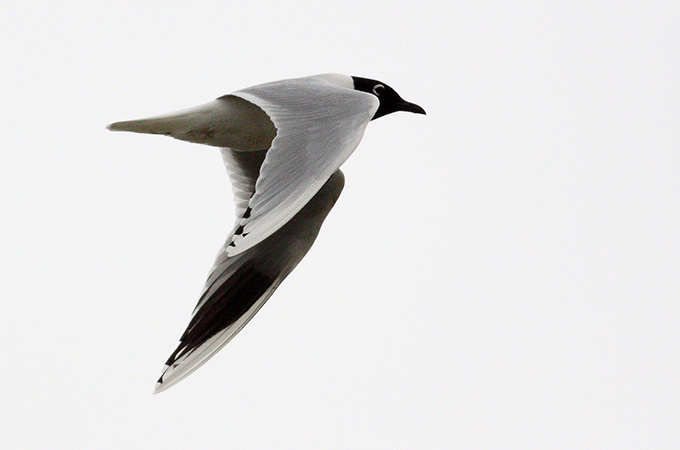
Gageo Island, April 25
After overnight rain, strong north and northwest winds throughout the day, gusting to Beaufort 7 or even 8. Despite these conditions, 104 species recorded. During the day, small numbers of egrets and shorebirds appeared to arrive and depart, with e.g. two Chinese Egret “through”, and a total of 16 shorebird species recorded during the day, including possibly Gageo’s first Black-tailed Godwit, single Sharp-tailed and Curlew Sandpipers, two Whimbrel, six Marsh and 12 Wood Sandpipers, single Long-toed and two Red-necked Stints and two Grey-tailed Tattler. Other species of note included the personal first Rufous-tailed Robin (two) of the spring, probably 20 Brown-headed Thrush, one or two Japanese Grosbeak, c 20 Pale-legged/Sakhalin Leaf and 27+ Eastern Crowned Warblers, 11 Yellow-browed and at least 26 Yellow Buntings in 1-Gu and 2-Gu (with others likely missed due to the high winds). A further outstanding highlight came with the discovery of a very worn and warm-toned ficedula flycatcher. Although its uppertail coverts were worn away, its paler bill base and warm tones clearly suggested identification as Red-breasted Flycatcher. A sound recording was made, and after independent verification of the calls by Magnus Robb (of the Sound Approach to birding), identification was confirmed as Red-breasted Flycatcher, a species recorded in Korea 10 or fewer times to date, since the first (also a very worn individual) on Eocheong in late April 2003.
Listen to the recording of the Red-breasted Flycatcher:
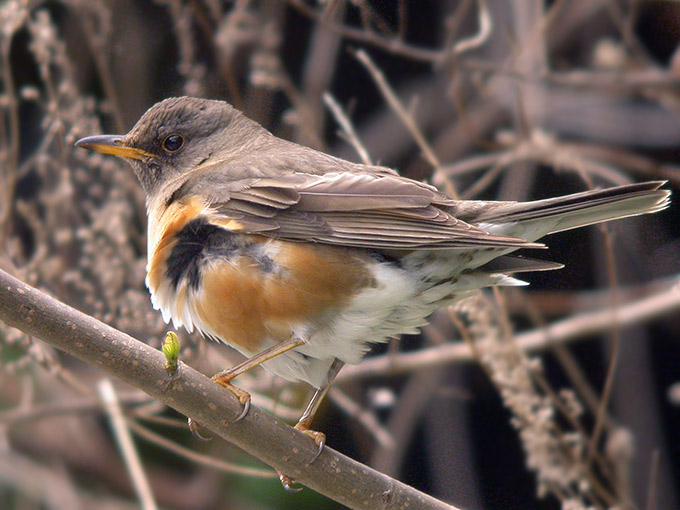
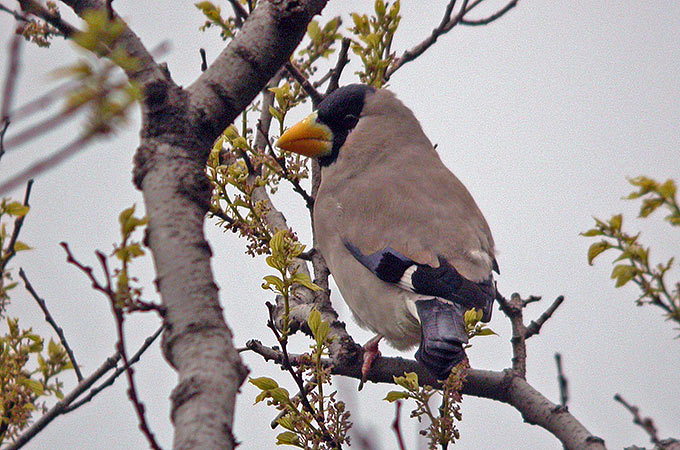

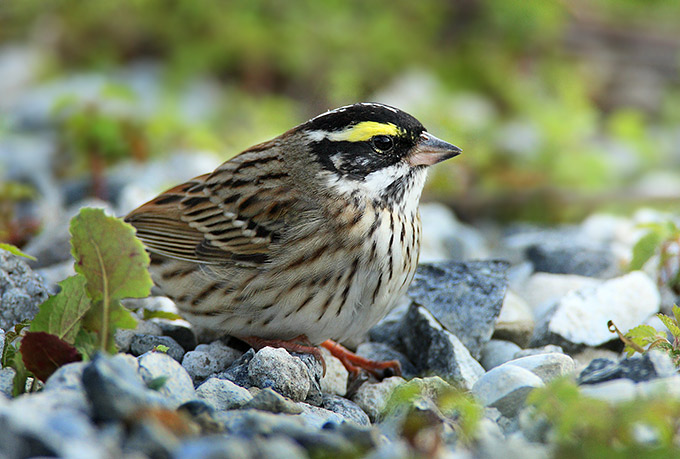
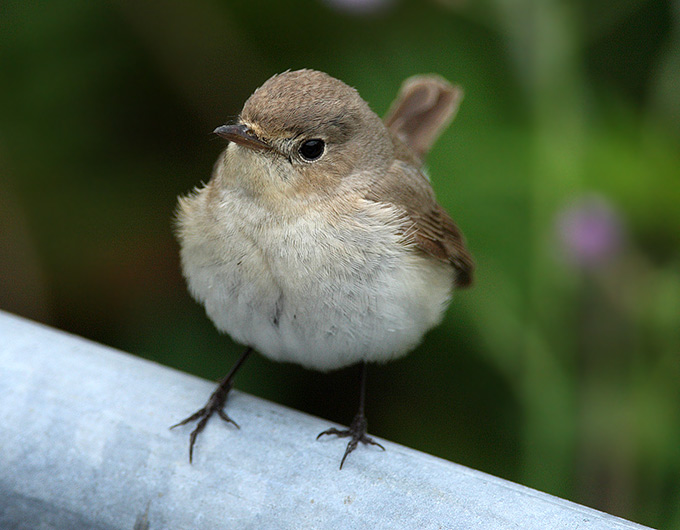
Jungmun, Jeju island, April 25
Thick undergrowth in front of an abandoned hotel held 2 Yellow Bunting.
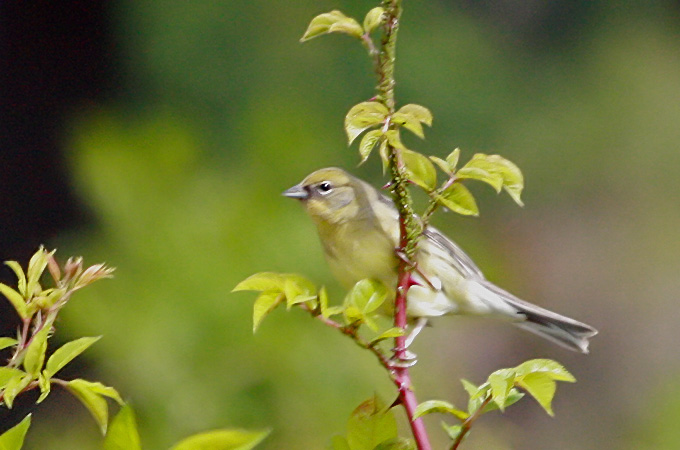
Gageo Island, April 24
With rain showers in the early morning turning to heavy rain and strong SE winds in the afternoon, limited time in the field (confined to the 1-Gu circuit) and some expectation of an arrival of new birds. In total, 82 species logged, with most significant being the increase of Yellow Bunting, a globally Vulnerable species, increasing from zero during the morning circuit to 19 in the afternoon circuit. Other species of interest included the personal first of the spring Shrenk’s Bittern flying in during the evening, two Mongolian Plover in the quarry, now three Black-winged Stilt and a Curlew Sandpiper on the “beach.”
Gageo Island, April 23
Another very good day, confined to counting migrants in 1-Gu because of moderate E/NE winds. In total, just over 100 species logged during the day, including the personal first White-breasted Waterhen, Eurasian Hobby and Green Sandpiper of the spring. Highlights included probably 3 Latham’s Snipe and a new Little Whimbrel, 3+ Light-vented Bulbul, and in the same gully behind the minbak as the (highly elusive) male White-shouldered Starling and one of the day’s two Chinese Blackbird, a Black Woodpigeon, a Japanese Night Heron AND a Large Hawk-cuckoo, seen in flight at close range (and possibly heard earlier in the day) - presumably different from the bird at 2-Gu, and hence the 4th national record.
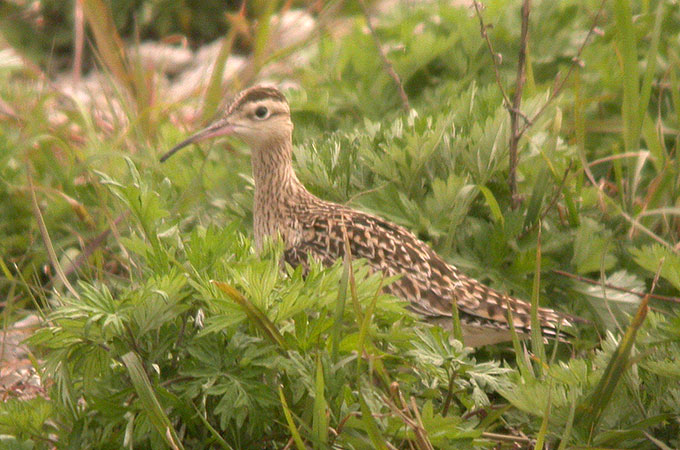
Seogwipo, Jeju island, April 23
Plenty of bird action in a gorgeous and quiet riverside park. Three Ashy Minivets (2 male, 1 female - possibly the same trio from a few days ago) were spotted flying back and forth between tall trees on either side of the small valley. A half dozen White-cheeked Starling lazily walked on grass next to a small stream, while four Yellow-browed Bunting moved nervously through riverside bushes. Best of the day was the nonchalant foraging of three Brown-headed Thrush in the grass next to the river. They reminded me a lot of American Robins in appearance and behavior! The trees along the river were teeming with at least a dozen Asian Brown Flycatchers busily feeding. Two male Blue-and-white Flycatchers were seen along a nearby path.
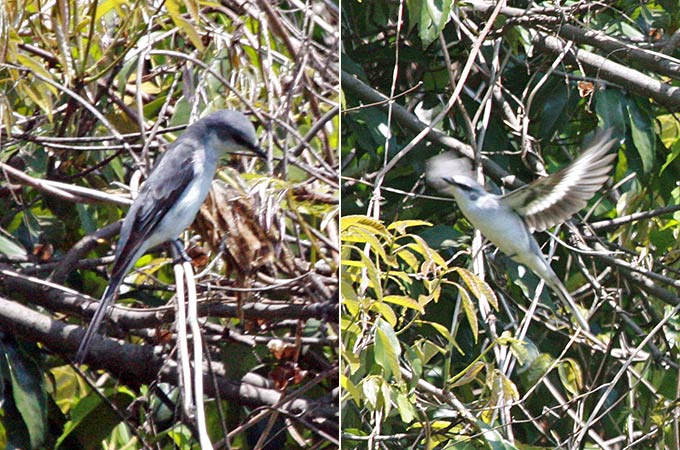
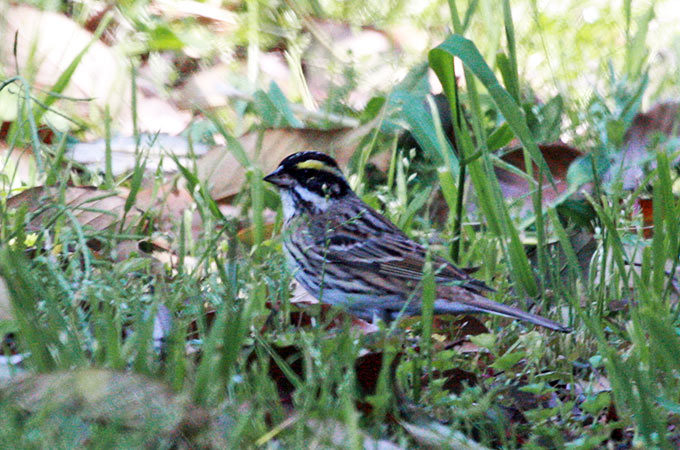
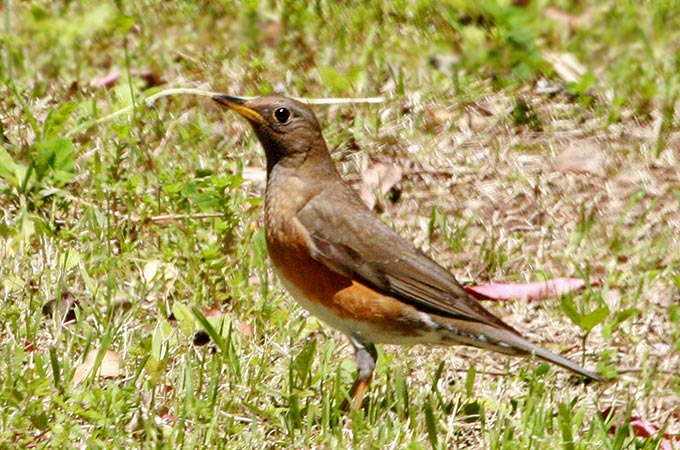
Gageo Island, April 22
In sunny, breezy conditions, the “beach” in 1-Gu (a concrete ramp in the harbour) produced two more surprises during the day: a Eurasian Spoonbill (exceptional on the offshore islands) and an Oriental Pratincole. The town also held the first Chestnut-cheeked Starling of Gageo’s spring (RN only). While RN covered Hangri in 2-Gu, finding a Little Whimbrel in addition to the Pacific Golden Plover still, NM covered 1-gu and the “Back Trail”, counting migrants and Black Woodpigeon. In total 96 species for the day, with the personal first Brown Shrike (1), Mugimaki (1) and Yellow-rumped Flycatcher (4) of the spring, and highlight a repeat "calling" by the 2-Gu Large Hawk-cuckoo (glimpsed in flight).
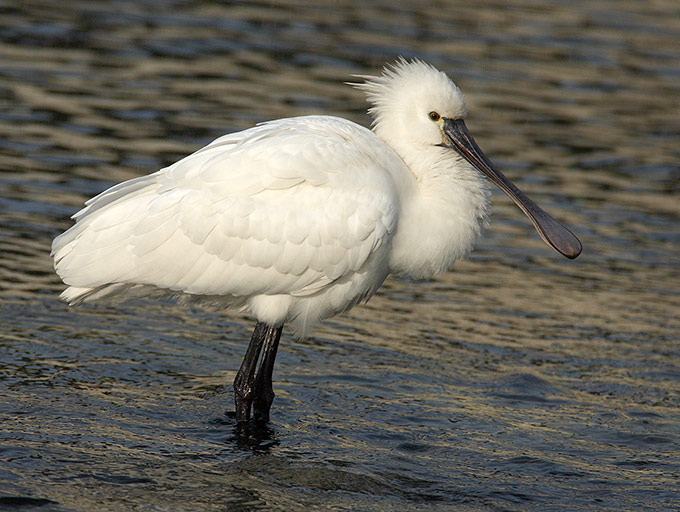
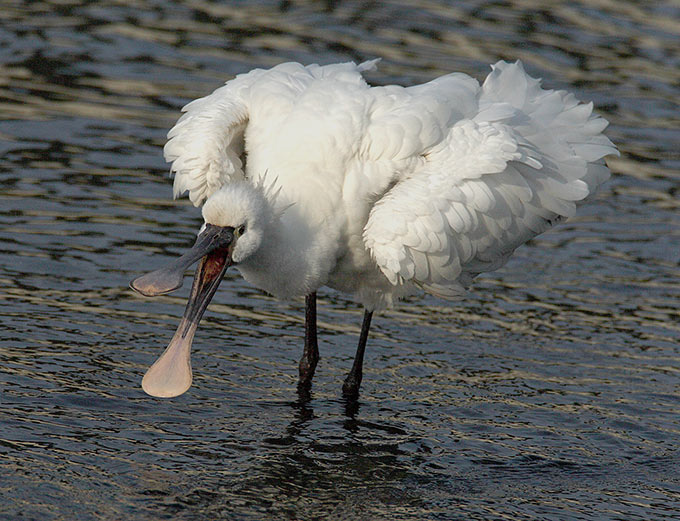
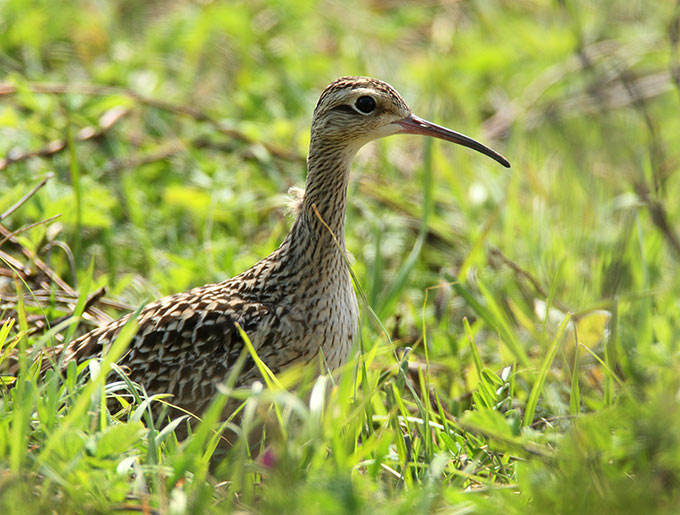
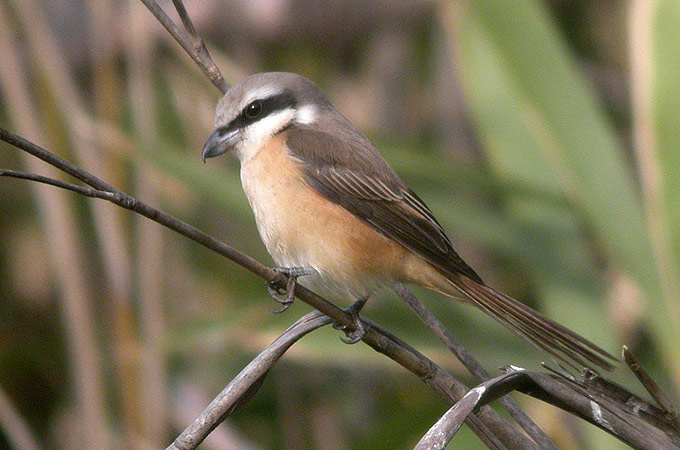
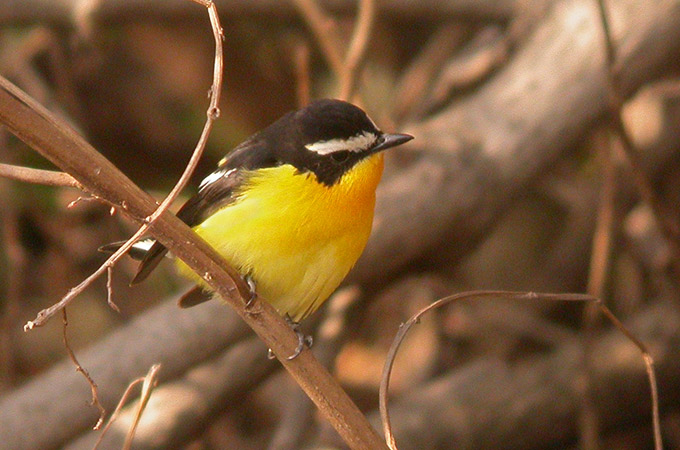
Gageo Island, April 21
An excellent day under clear skies, with south-westerly then north-westerly winds. Covering only 1-Gu and 2-Gu, at least 99 species logged for the day, including 7 Chinese Pond Heron and the 4 Chinese Egret still, single Grey, Pacific Golden and Greater Sand Plovers, single Temminck’s and Long-toed Stints, 2 Oriental Pratincole, and a range of further highlights including a Light-vented Bulbul in 2-Gu, the male Citrine Wagtail still, 2 menzbieri Pechora Pipit and 12 Yellow Bunting. Both outstanding highlights came in the late afternoon/evening: the first was a Wood Warbler seen for only 3 seconds at 2-Gu, perched in a bare-branched tree in full sunlight; the second was a singing Large Hawk-cuckoo about 1km south of 2-Gu. This is considered to be only the third national record, with previous records both in May on Socheong, in 2007 and 2008. Glimpsed by RN, the song was recorded by NM.
You can listen to the recording of the Large Hawk-cuckoo here:
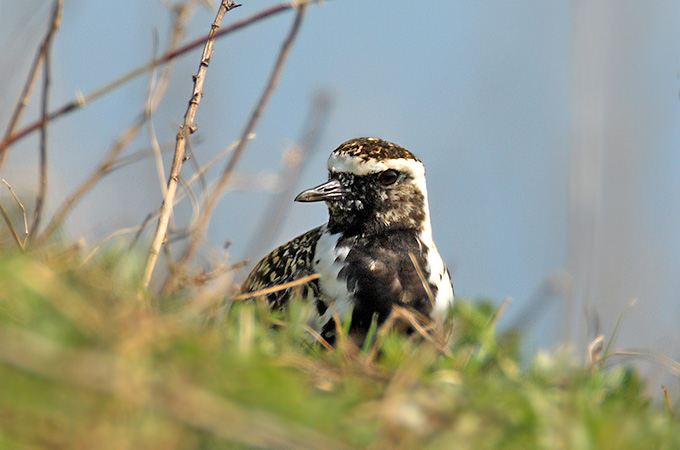
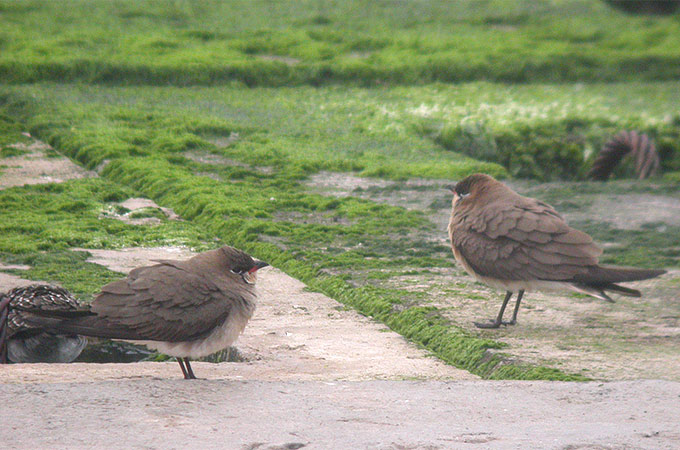
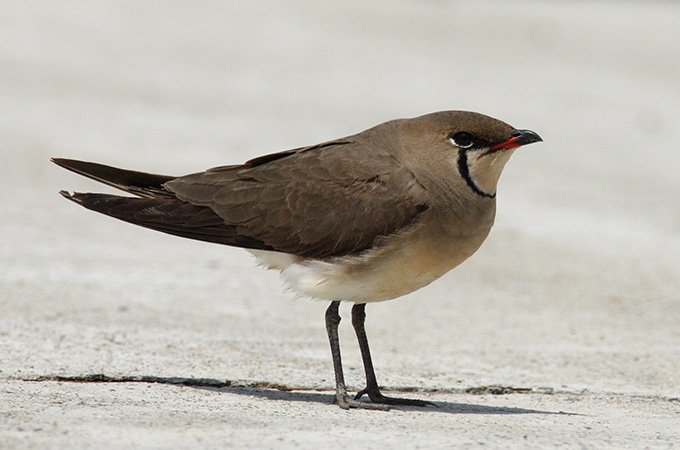
Seogwipo, Jeju island, April 21
A farmer’s field on the outskirts of town initially didn’t look promising for birds, due to the extensive netting placed over the fields. However, a small flooded area without netting held 6 Wood Sandpipers and a single Sharp-tailed Sandpiper. A previously spotted whitish starling reappeared nearby, and turned out to be a White-shouldered Starling. A Cattle Egret perched in a nearby tree.
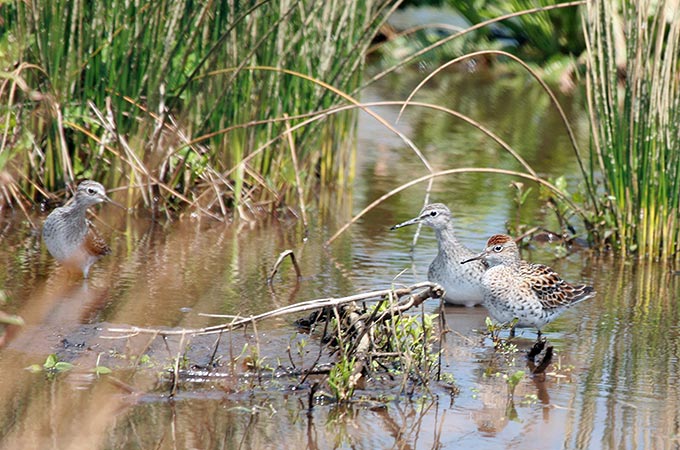
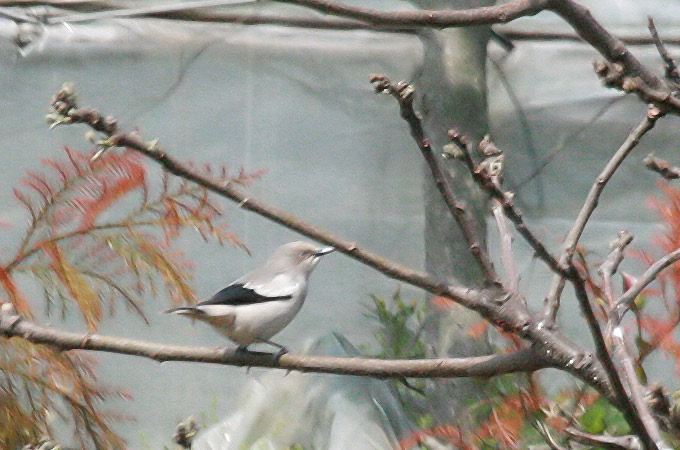
Gageo Island, April 20
With overnight rain continuing until 3 pm, and strong SE winds, 66 species logged in 1-Gu, including the personal first Chinese Egret (4), Chinese Pond Heron (2) and Chestnut Bunting (1) of the spring, and at least 12 Narcissus Flycatcher, showing a broad range of (individually variable) plumages.
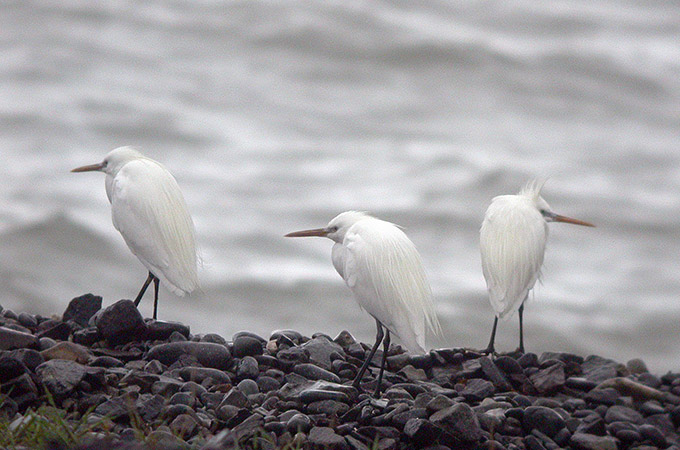
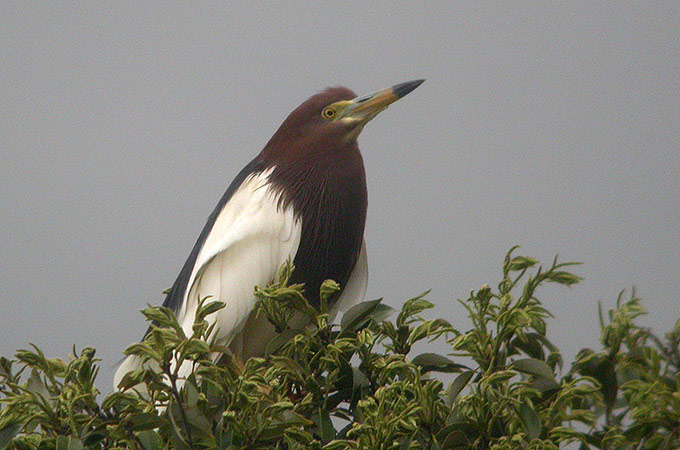
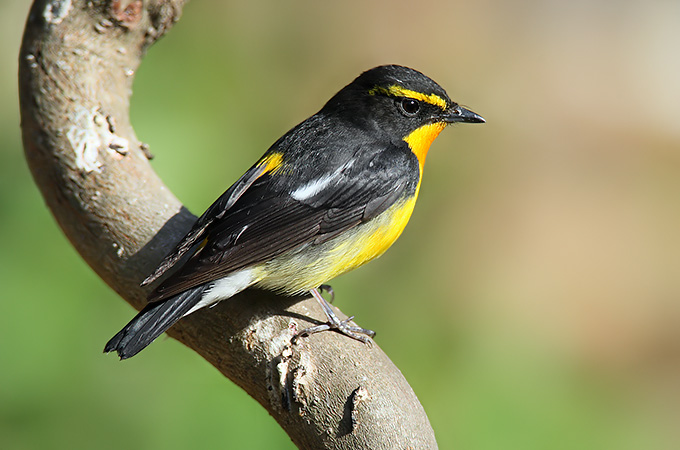
Gageo Island, April 19
In increasingly cloudy conditions, two circuits of 1-Gu (once in the morning, and again in the afternoon) produced over 80 species, with highlights including a probable but very distant Black Stork heading west over the sea; a rather probable Sakhalin Leaf Warbler (based on its long primary projection, showing 7 tips beyond the tertials, its warm rusty tone to the rump and tail, and its slightly fuller call), the spring’s personal first Pale-legged Leaf Warbler, and a Northern House Martin.
Mara-do, Jeju, April 19
Sunny and windy on Mara-do, the southernmost point in South Korea. The small island is mostly covered with grass, except for a small stand of pines at the centre of the island. At least 6 Zitting Cisticola were seen noisily swooping up and down from grassy fields. Some Korean bird researchers I re-met on the island told me that at least 10 pairs breed on Marado. Six Male Narcissus Flycatchers were seen, 2 of which were immature.
Two Peregrine Falcon hovered menacingly nearby. One Brown-headed Thrush was seen skulking among the low pines. Three Eastern Crowned Warbler were seen in the same stand of pines. Three Pacific Reef Heron were spotted on cliffs. About two dozen Barn Swallows and White-rumped Swift flew deftly over the island. Several small groups of Buff-bellied Pipit were seen at the cliff’s edge, and single examples of Eurasian Hoopoe, Black-faced Bunting, Siberian Stonechat, and Pale Thrush were also seen. Five Streaked Shearwater were seen from the ferry.
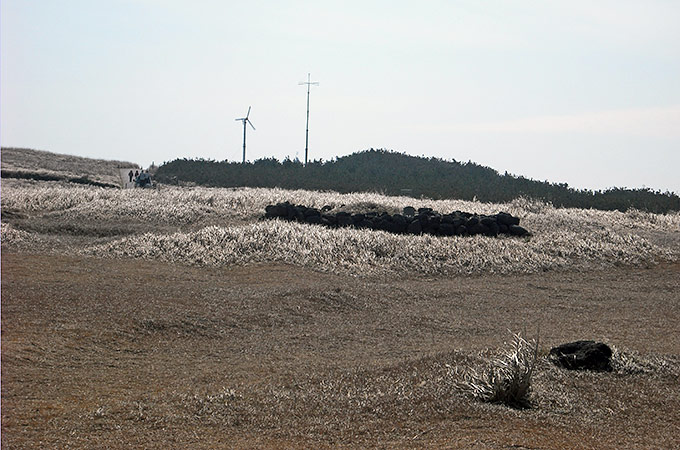
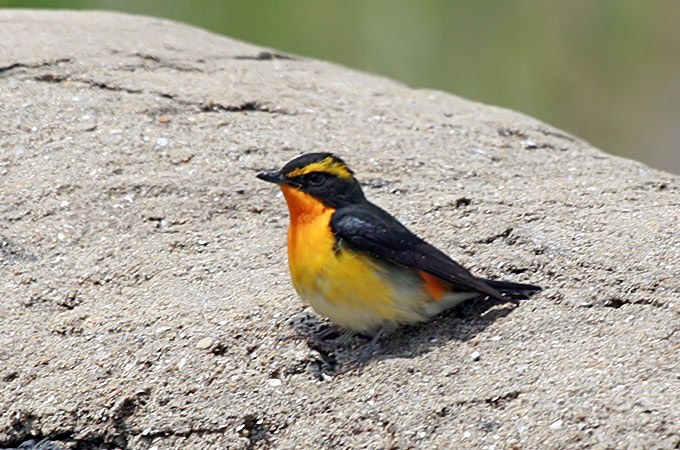
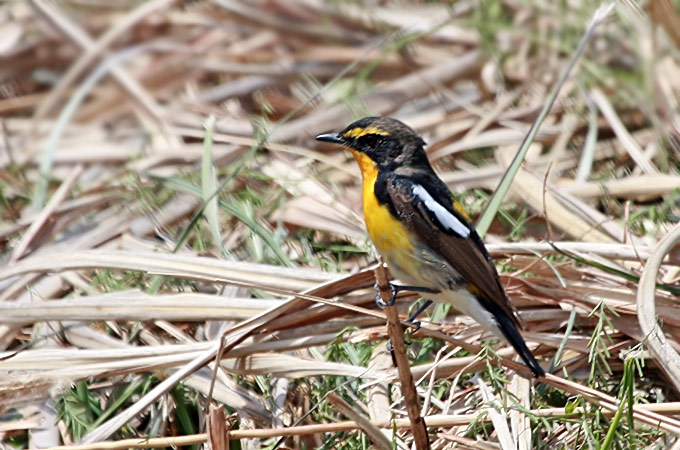
Dokjeok Island, April 19
Best of the following morning was a male Chinese Blackbird in someones back garden, and an elegantly-plumed Chinese Egret on the beach.
The day also added a handful of Meadow Bunting, Barn Swallow, 2 Grey-backed Thrush, 2 Common Kingfisher, 3 Green Sandpiper, a late Common Buzzard, 3 singing Korean Bush Warbler, lone Hawfinch, Asian Brown Flycatcher, 1 Naumann's/ Dusky Thrush hybrid, and a few Yellow-browed Warbler, making a total of 55 species in 24 hours.
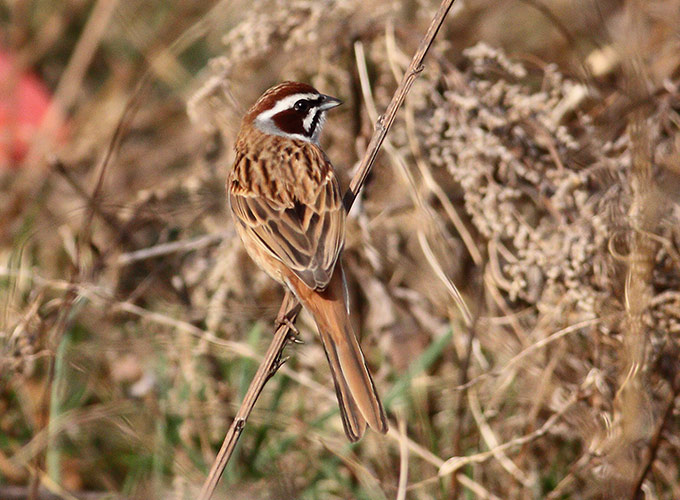
Ganghwa Do, April 19
It was a wonderful spring day on the island. Droves of people were harvesting edible greens all over the place. I did manage to see 8 Grey Starling, 2 Olive backed Pipit, 2 Grey Wagtail, 1 Common Kestrel! , 75 Dusky Thrush, 4 Cattle Egret mixed in with numerous Little & Intermediate Egret, and 1 very confiding Varied tit.
On the mudflats I endured a weak high-tide with highlights as follows: 300 Dunlin, 6 Little Tern, 12 Black-faced Spoonbill, 200 Bar-Tailed Godwit, 5 Grey Plover, strong numbers of both Eurasian and Far-eastern Curlew.
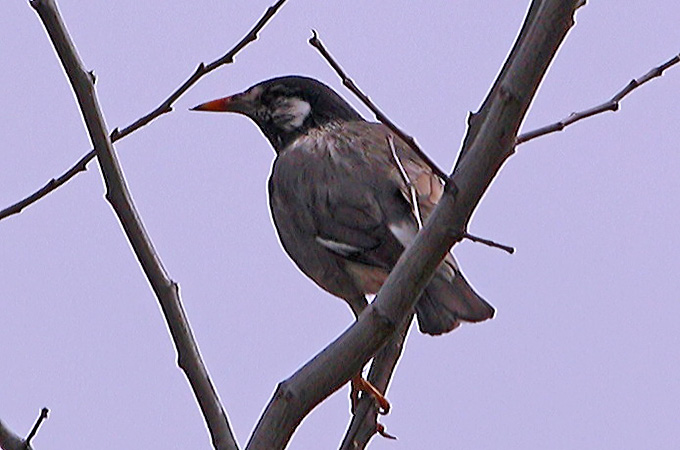

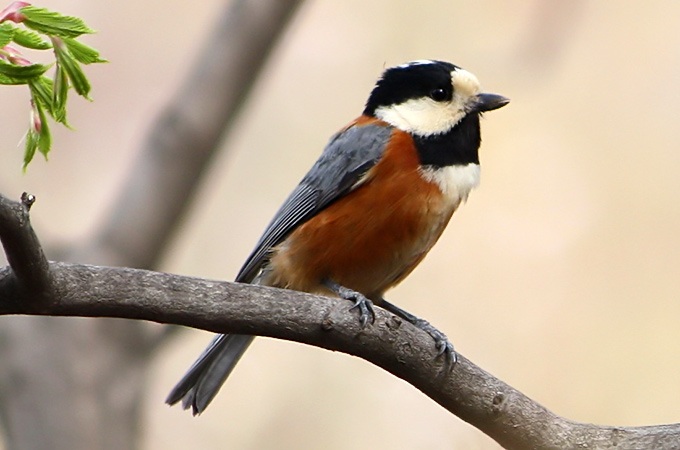
Gageo Island, April 18
A very decent (for mid-April) 66 species logged during the day in 1-Gu in warm (19C) and sunny conditions. Species of most note included between 35 and 44 Black-throated (or Arctic) Loon, now two Black-winged Stilt, the personal first Oriental Cuckoo and Oriental Reed Warbler of the spring, and the male White-shouldered Starling and Citrine Wagtail still.
Dokjeok Island, April 18
After an uneventful sea crossing punctuated only by swarms of aerobatic Black-tailed Gulls grabbing tidbits from excited ferry passengers, two hours in the late afternoon found an island dripping with tired migrants and prowling domestic cats.
Virtually every patch of bare ground was dotted with (in order of abundance) Black-faced Bunting, Olive-backed Pipit, Dusky Thrush, Buff-bellied Pipit, and lesser numbers of Brambling.
On the rocky foreshore, 2 "Eastern" Oystercatcher and an out-of-place Coot. Leucopsis White and Grey Wagtails scoured the rice paddies, along with several Red-throated Pipit, an Intermediate Egret, 1 Little Ringed Plover, and 1 macronyx-type Eastern Yellow Wagtail.
In the woods, leaf litter rustled with Pale, White's and 2 Naumann's Thrushes, as well as a few Asian Stubtail, 1 Blue-and-White Flycatcher, several Eastern Crowned Warbler, singing Yellow-throated Bunting and Red-flanked Bluetail.
In open scrubby areas, pockets of Little Buntings, White-cheeked Starlings, Siberian Stonechats, and 2 Chestnut-eared Bunting a pleasant sight.
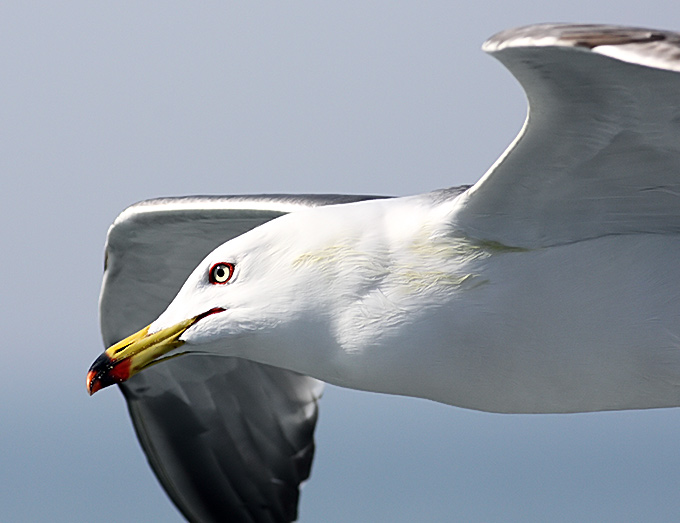
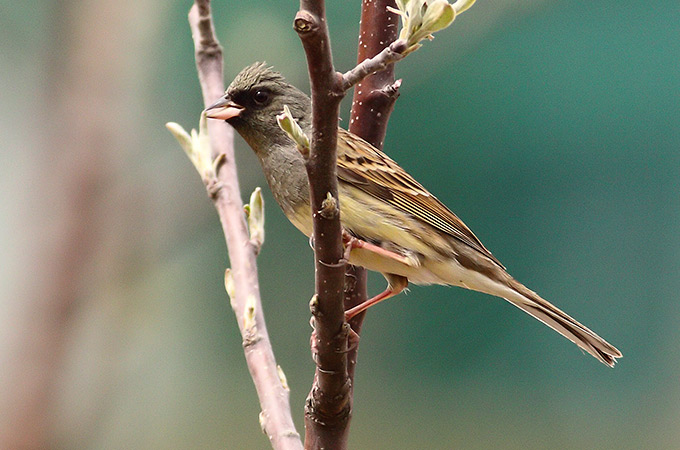
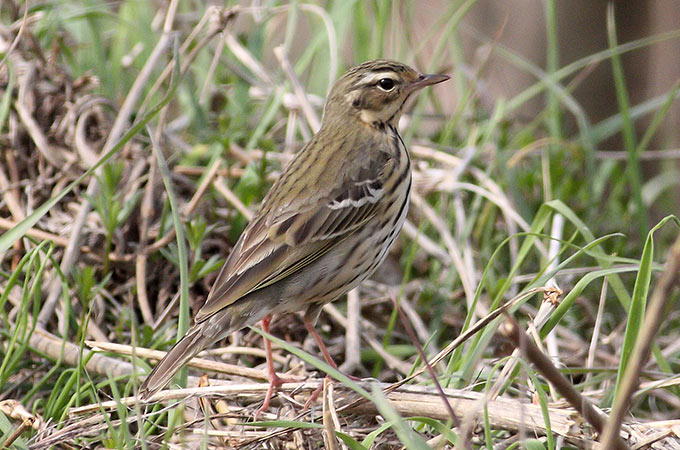
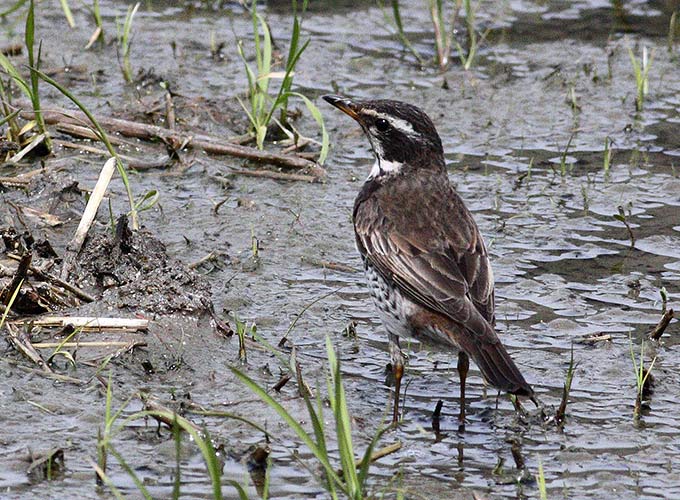
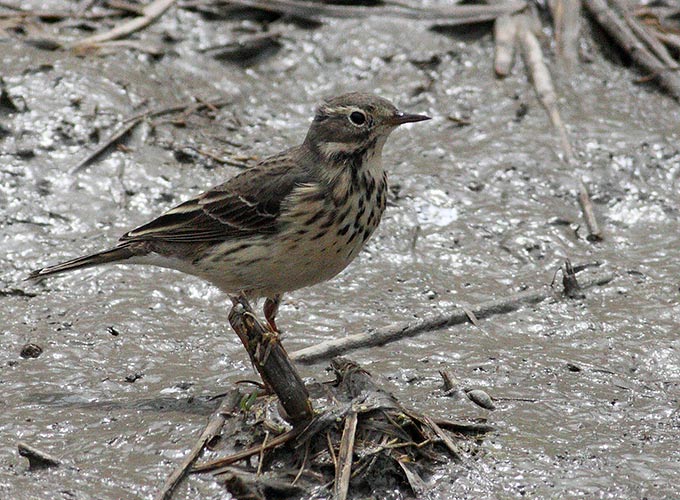
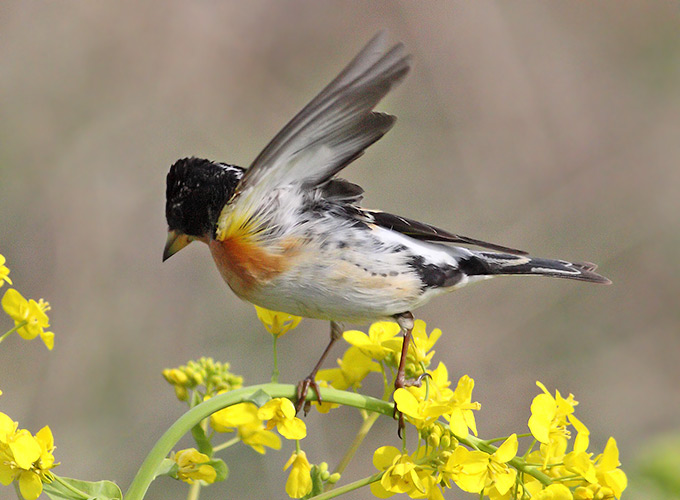
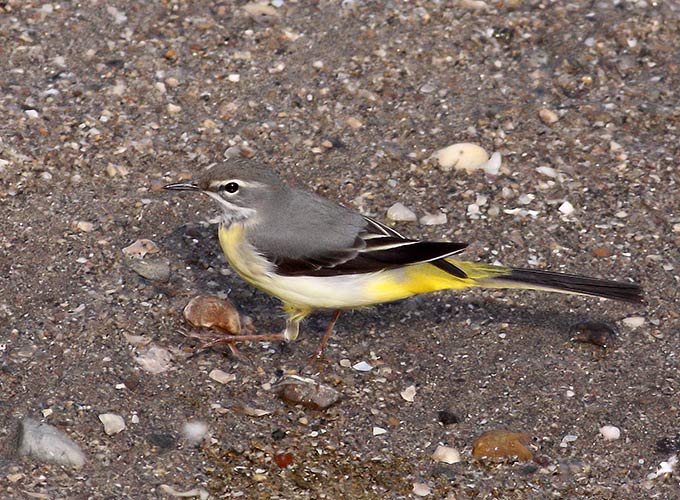

Seogwipo, Jeju island, April 18
A sunny stroll around a valley near Jeongbang waterfalls revealed some new arrivals to the area. Notable birds spotted included 3 Ashy Minivets (2 male, 1 female), 2 stunning male Blue-and-white Flycatchers, and 1 Asian Brown Flycatcher. Many active and vocal Blue Rock Thrush were also seen.
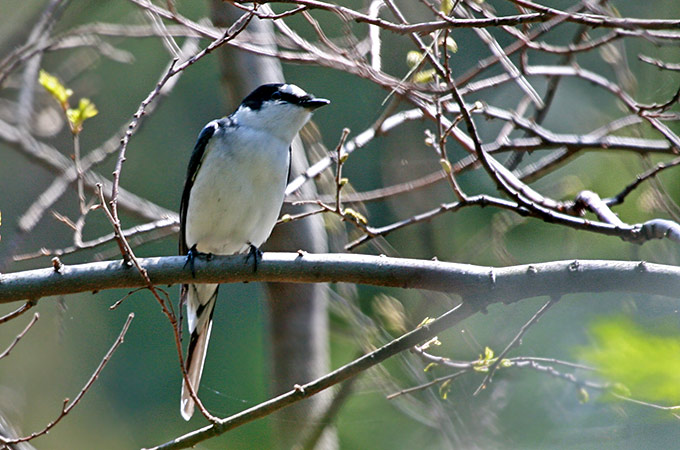
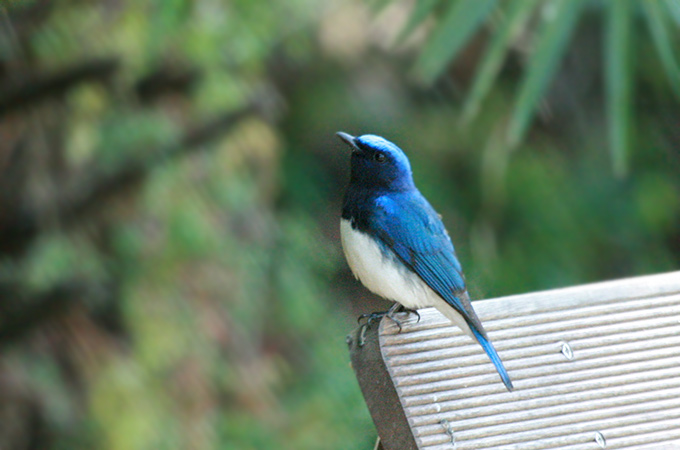
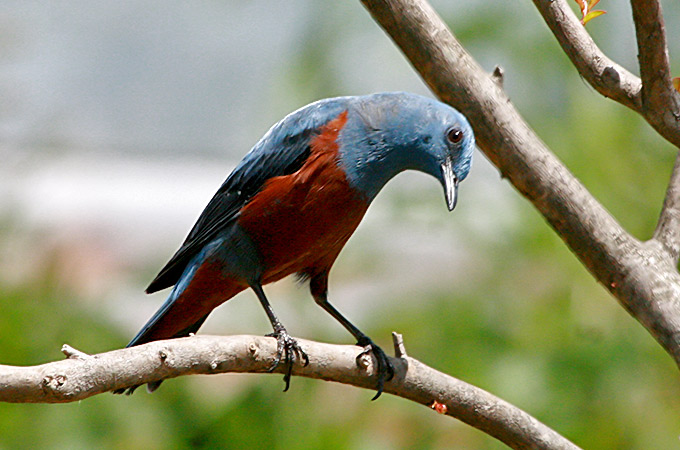
Gageo-do, April 17
A supplement to Nial Moores’ report. On Gageo, the first Yellow Bunting found wore a leg-band; “KA” and “27” appear quite legible; the rest is open to interpretation.
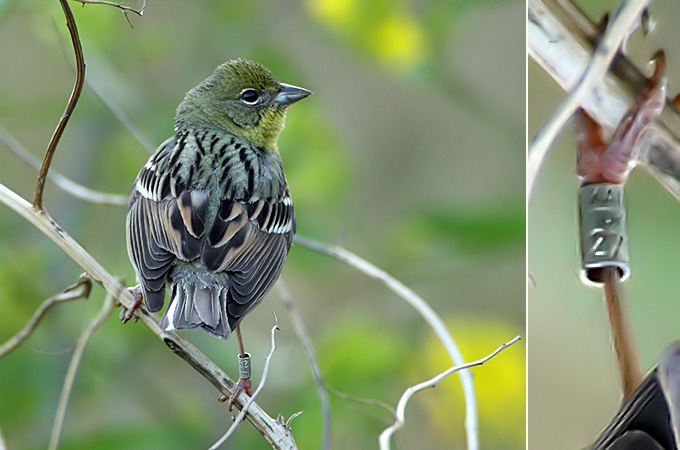
Mokpo Ferry to Gageo, and Gageo, April 17
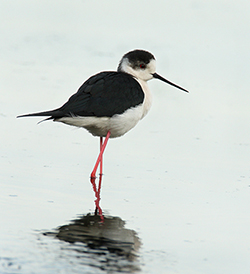
Photo © Robin Newlin
In clear conditions with light seas, few birds from the ferry to Gageo, but these included 11 Arctic, one Pacific, one Red-throated and 10 loons sp, and most surprisingly, between three and five Yellow-billed Loon.
On Gageo, good diversity (66 species) and good numbers of birds (presumably left over from rain of a couple of days earlier), with most numerous Black-faced Bunting (c. 160). Species of most note included a Brown-headed Thrush, Narcissus Flycatcher (13 males, including one showing some dark greenish tones to the upperparts, faintly bi-colored ear coverts, and a white “spur” on the wing), single adult male Russet Sparrow, White-shouldered Starling and Citrine Wagtail, and the personal first Eastern Cattle Egret (1), Asian Brown Flycatcher (5), and Black-winged Stilt (1) of the spring.
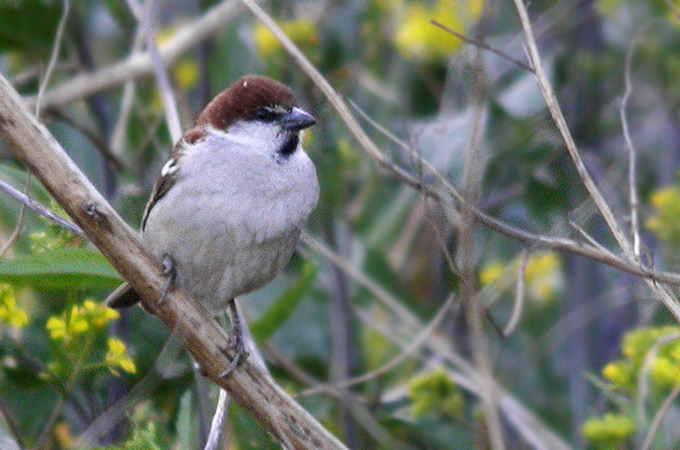
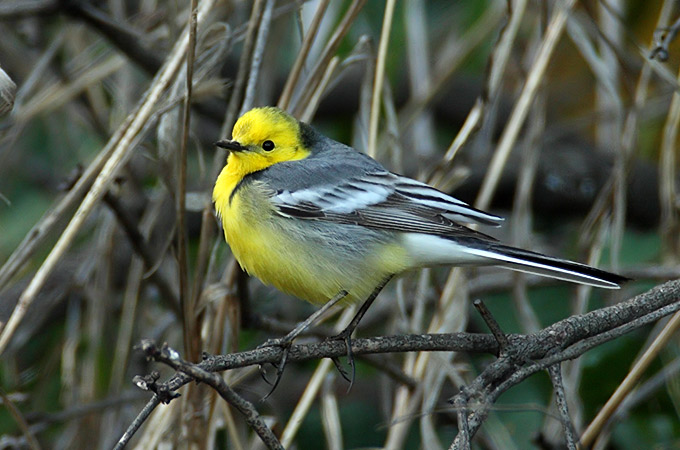
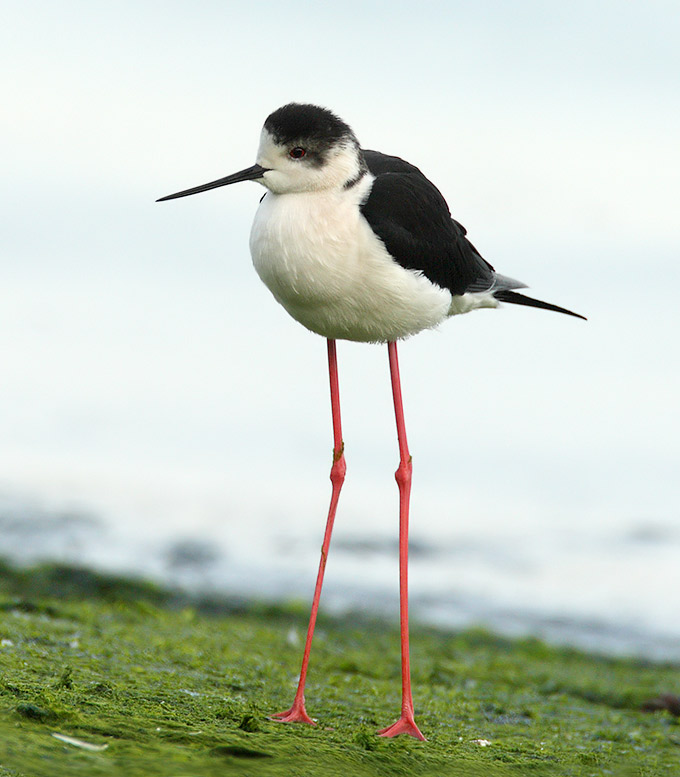
Mokpo Namhang Urban Wetland, April 16
At Mokpo Andreas Kim and I visited the local wetland: highlights were 130 Bar-tailed Godwits, 16 Great Knots, 2 Sharp-tailed Sandpiper, 3 Whimbrel, 100+ Kentish Plovers, 100+ Dunlin and good numbers of the local Grey Herons, Wigeon and Mallards.
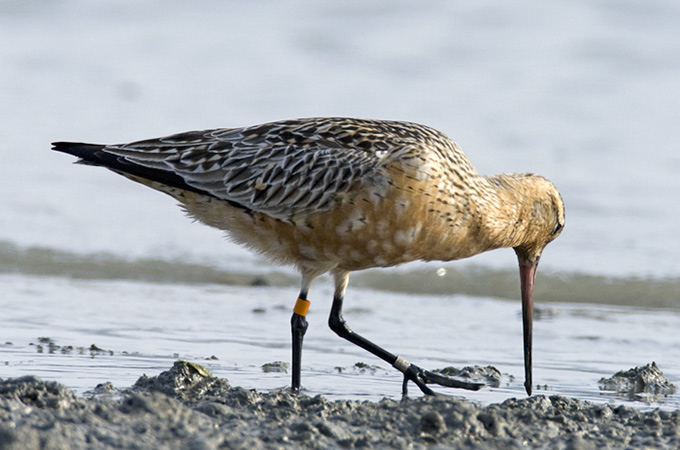
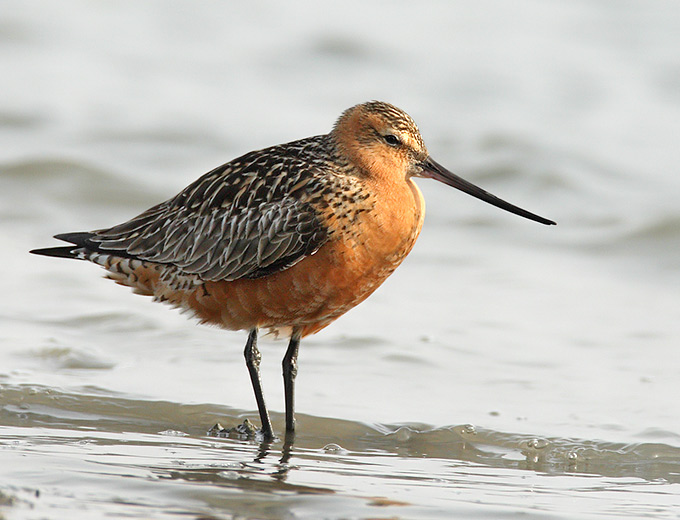
Socheong and then ferry to Incheon, April 16
Bright and clear at dawn and through the morning with light to moderate northerly winds. Still large numbers of Brambling present (1800 logged in the main areas), and decent numbers of Black-faced Bunting (c. 200), including one singing personata. Other birds of most note included possibly a new Ochre-rumped Bunting in at the lighthouse, and the Oriental Pratincole, the Japanese Robin of 2 days before still in the stream, and the baicalensis White Wagtail still. Few birds from the ferry, but these included single Streaked Shearwater, Yellow-billed Loon and South Polar Skua – the latter species especially still very scarcely reported in Korea.
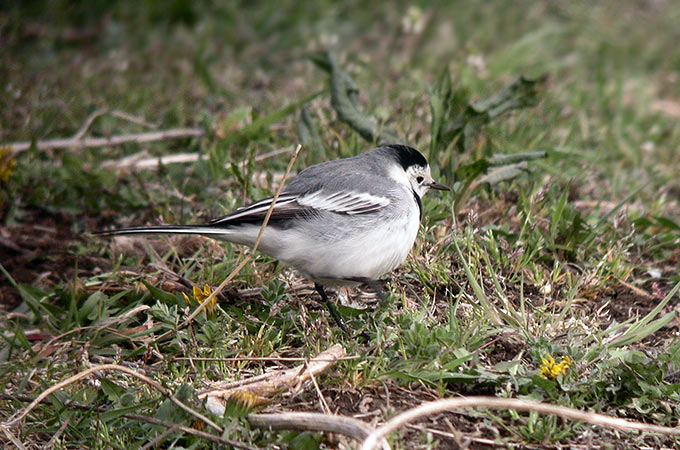
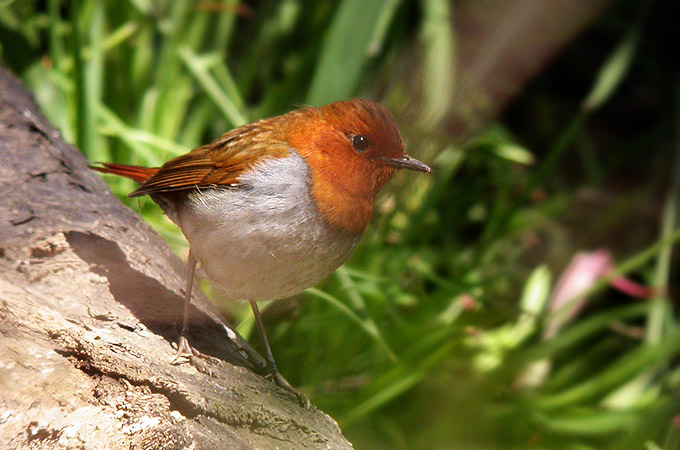
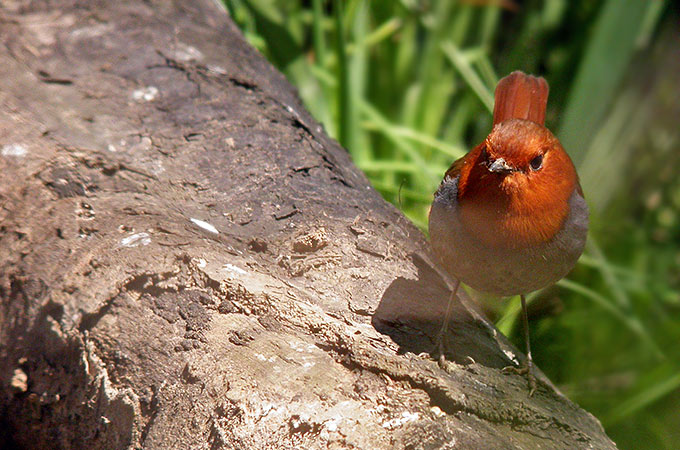
Socheong, April 15
Another day to remember! After clear skies overnight, dawn broke with light winds and a heavy overcast. As fog patches formed and in anticipation of a rain-induced fall, a brisk hike to the lighthouse was timed just right – and as the first rain-drops fell at 0930, the sky filled with “falling” birds…In the first fantastic ten minutes alone, at the very least 2500 Dusky Thrush, 600 Olive-backed Pipit and over 100 Brambling tumbled in onto the island in one wave after another (with a single flock of 300 thrush followed by a mixed mass of 1500 birds, containing birds ranging in size from Siberian Stonechat up to Grey-faced Buzzard!). The arrival continued with decreasing intensity for two hours, with 10 birds a minute still arriving at 11 AM. Even though time was “lost” to rain and the strong winds that followed, 85 species were logged during the day, with very conservative estimates of the most numerous species including 4000+ Dusky Thrush, 2500+ Brambling, 1000+ Olive-backed Pipit, 300+ Black-faced Bunting and at least 150 Buff-bellied Pipit. Further species of note included 174 Ancient Murrelet and two Mandarin Duck on the sea, two Purple Heron coming in off the sea in the first rain-wave, an Oriental Pratincole, a Greater Short-toed Lark, a baicalensis White Wagtail, 35 Pallas’s Leaf Warbler and the personal first Yellow-browed Bunting and Common Rosefinch of the spring.
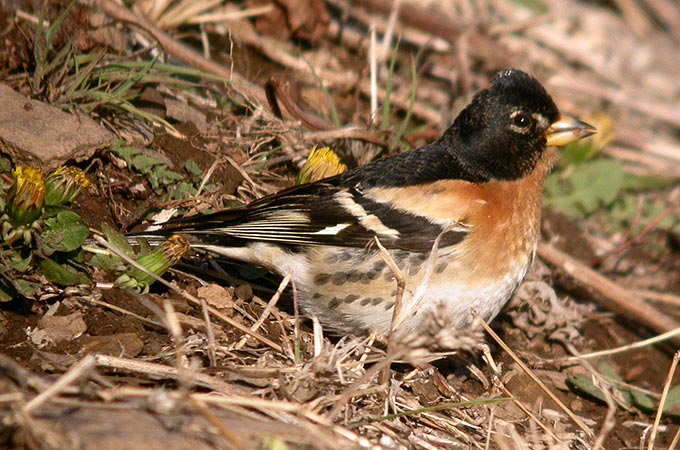
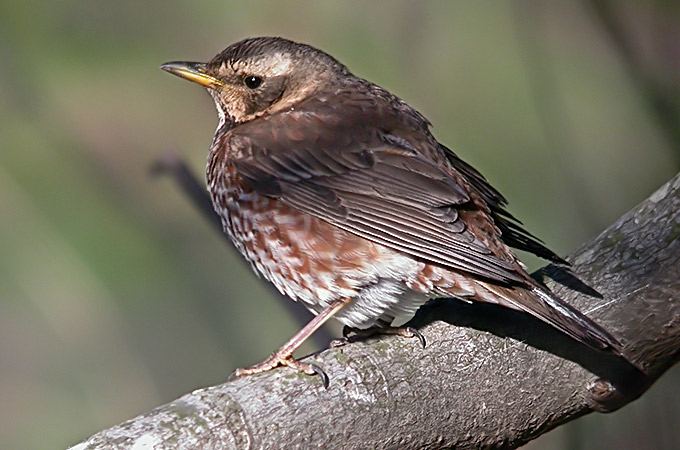
Socheong, April 14
Clear skies overnight and at dawn, and reduced numbers of many of the more numerous species compared to the 12th. Despite this, 63 species were logged including several species of note, especially at the lighthouse. There, a series of highlights through the morning included the personal first Chinese Grosbeak (2) of the spring, both First-winter female Black-throated and then Red-throated Thrushes, an Ochre-rumped Bunting, an Eastern Oystercatcher, and an unknown bird song. Soon after hearing the song, a small warbler moved into the gully to feed, appearing like a small and bright Eastern Crowned with two strong yellowish wing-bars, feeding unusually by clinging tit-like to branches and the trunks of trees… Although it did not flick its wings as it fed (apparently “characteristic” of the species), identification was made as Korea’s first Claudia’s Leaf Warbler Phylloscopus claudiae (Further opinions from observers with experience of the species are being sought; for more images please go to: http://www.birdskorea.or.kr/Forum/Records/4609). In the afternoon, an increased number of Brambling (120+) and Red-flanked Bluetail, and a new male Japanese Robin were found in the stream (St Valley).
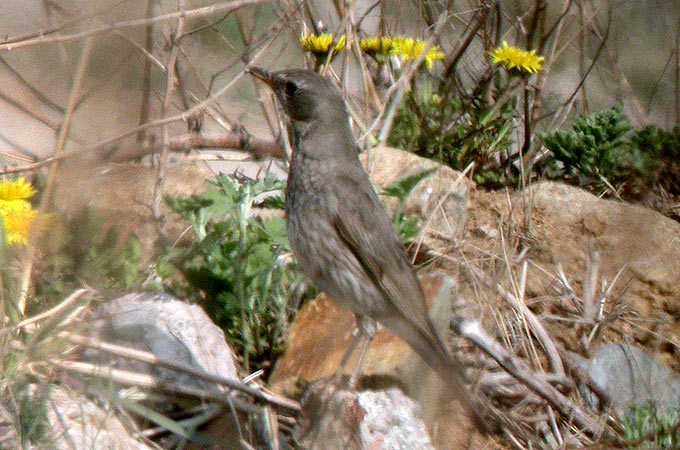
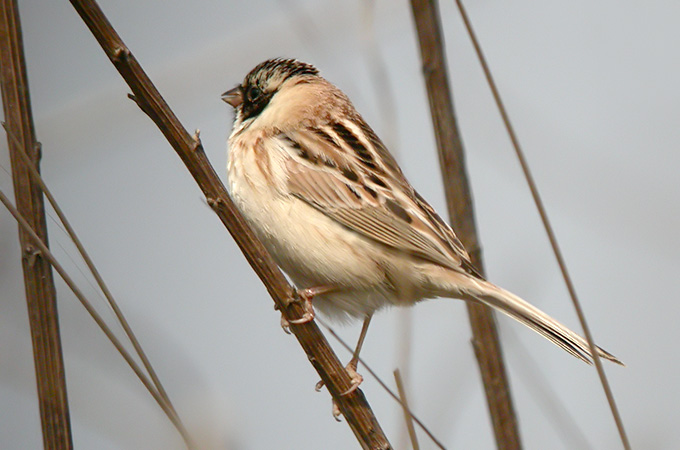
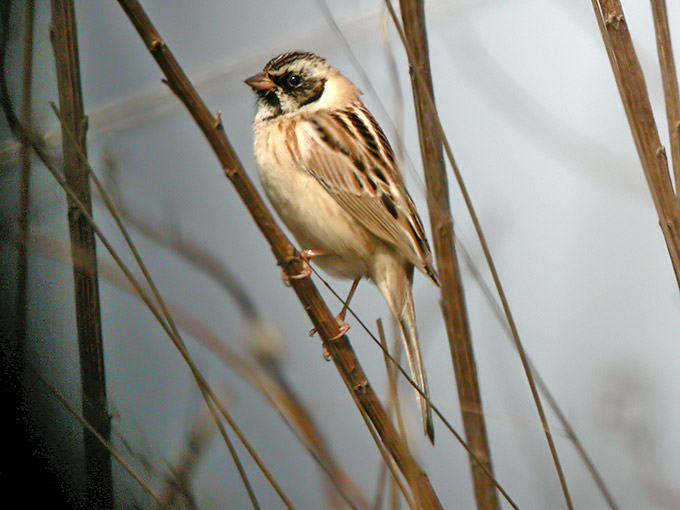

For more images please go to: http://www.birdskorea.or.kr/Forum/Records/4609
Socheong, April 13
With dense fog all day (until near dusk, when it rapidly cleared), little time spent in the field and few species logged. Of most note were 100 Streaked Shearwater offshore in the evening, and a Striated Heron (the personal first of the spring), heard after dark, along with one Grey and at least three Black-crowned Night Herons.
With such huge potential for bird research and eco-tourism (both of which could/would benefit the islanders and the nation in the long-term) it is a great shame that even this small and rather remote island, with only a few hundred residents at most, still has four or five active “construction” sites. It is especially troubling too that at a time of drought much of the freshwater that is available to birds and other wildlife (in the one remaining stream and in natural springs) is still being pumped and extracted to use in mixing concrete, for e.g. a new seawall and huge tetrapods, and especially meaningless to most, a road to nowhere in the east of the island.
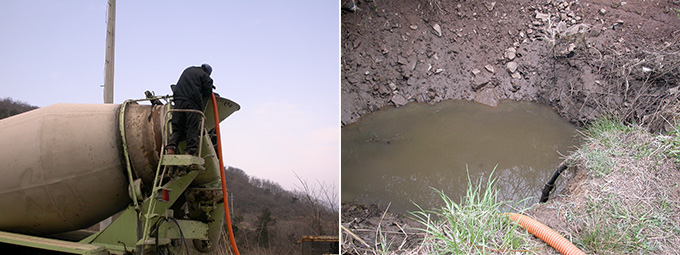
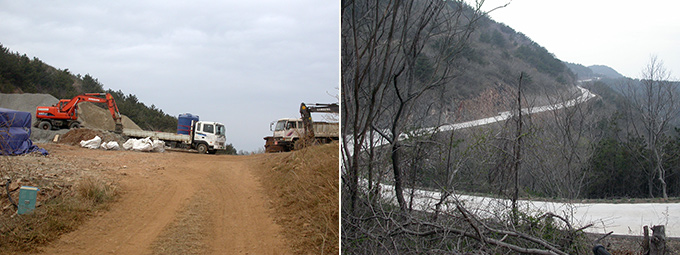
Socheong, April 12
In warm sunshine and light southerly winds, turning to overcast by late afternoon, a survey of almost all the island - from the lighthouse in the southwest to SE corner and NE point. In total, 68 species logged including species known to breed here (e.g. Temminck’s Cormorant, Peregrine Falcon and Meadow Bunting), a few lingering winter visitors, and a good range of spring migrants. A male Japanese Robin, two Brown-headed and five male Grey Thrushes, and a male Narcissus Flycatcher all contributed to a Japanese “feel” of the day, while other personal firsts of the spring included a Richard’s Pipit, a male Siberian Rubythroat, and a Pale-legged or Sakhalin Leaf Warbler. Single Greater Short-toed Lark, Light-vented Bulbul and Chinese Blackbird and two Red-Billed Starling were also logged. Most numerous species on the land included White’s (60), Pale (70) and Grey-backed Thrushes (40) and Red-flanked Bluetail (65) still, while 41White-winged Scoter and 38 Black-throated (or Arctic) Loons at sea around the island also seemed noteworthy.
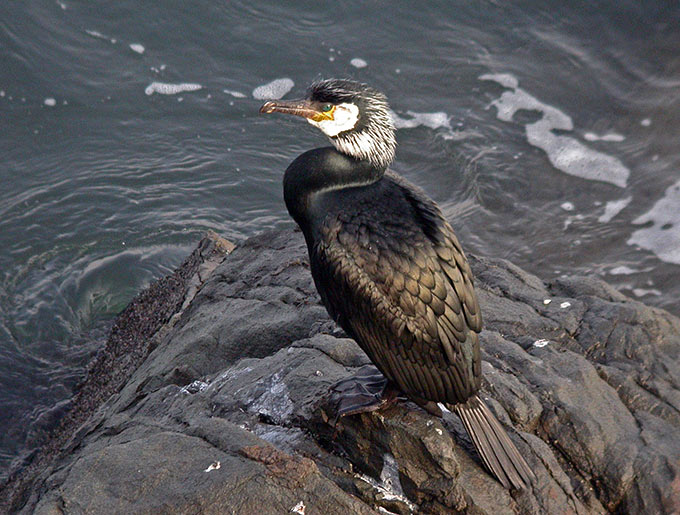
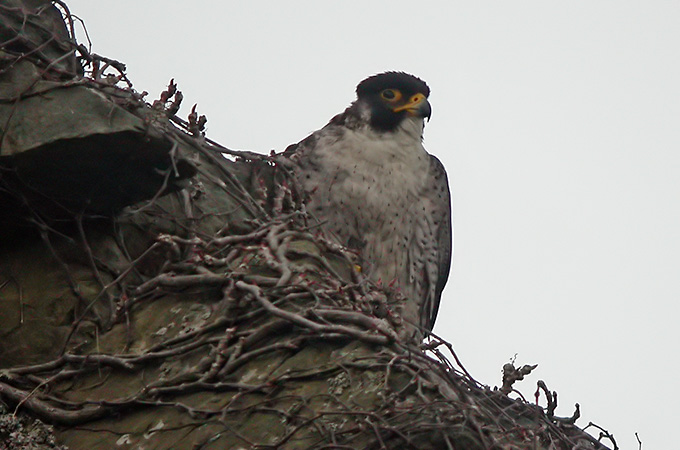
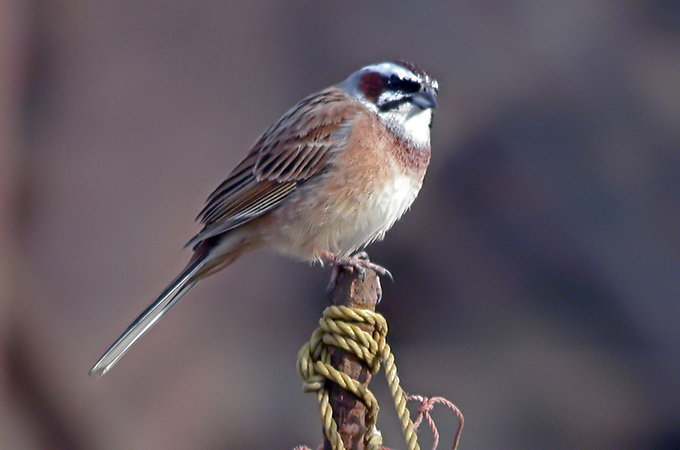
Aham-do/Songdo, April 12
Aham-do (am):- A patrolling Little Tern is the years first: nearby 39 Grey Plover, 1 Black-tailed Godwit and 2 Eastern Oystercatcher.
On the Golf course, 3 Grey-backed Thrush, 3 Pale Thrush, 1 Eastern Crowned Warbler and 1 Korean Bush Warbler are all newly-arrived migrants.
Also here 2 Red-flanked Bluetail, 1 Naumann's and 11 loosely flocking Dusky Thrush.
Songdo mudflat (pm): Seen well through the scope was an apparent Long-billed Dowitcher -obviously smallish, short-legged and stocky, with a striking white supercilium set against a solid slate grey face and neck. Aside from a shortish, thick, straight bill, structurally it appeared deep-chested, thick-necked, with at times a very upright posture and markedly steep forehead. A golden brown patterning showed well down the back and mantle in sunlight, and the breast showed patches of russet coming through. The briefly stretched wing appeared all dark, with no wingbar.
Elsewhere on the mudflat, still 50+ Common Shelduck in a feeding group, some 650 Great Knot, 4-500 Dunlin, 150+ Bar-tailed Godwit, 200+ Saunders's Gull, 2 Taimyr Gull, c.40 Whimbrel and perhaps 80 Eurasian Curlew within view: Far-Eastern Curlew are now much reduced. Otherwise similar birds to last week.
On the lagoon, a neat pack of 15 Spotted Redshank were accompanied by 1 Common Redshank and now 30+ Common Greenshank, not to mention the usual 9 Black-faced Spoonbill and Mongolian Gulls, which are now sitting on 8 or 9 nests.
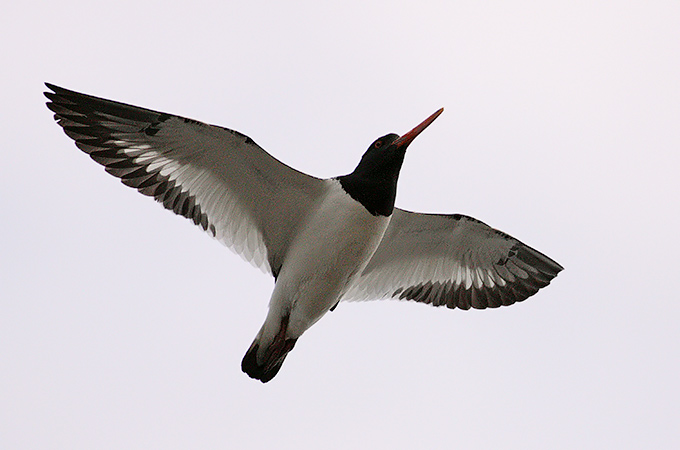
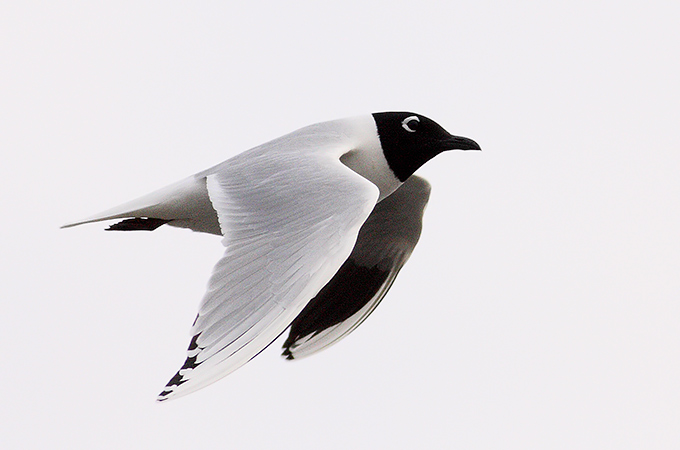
Socheong, April 11
Another day, another island! From the ferry, few species with highlights being a Yellow-billed Loon and over 100 Ancient Murrelet, most of which were within 10 km of Socheong (with a smaller group of this species flying alongside the ferry for 2 or more minutes – at a sustained speed of 51 Kph). On the island, warm sunshine and large numbers of birds, with 60 species logged in only 5 hours. Species of most note included the personal first Grey Thrush (2) of the spring, while warblers were a little more numerous than on Eocheong the day before, including 15 Asian Stubtail, four Korean Bush, two Dusky, six Pallas’s Leaf and three Eastern Crowned Warblers.
Eocheong, April 10
In continuing bright sunshine and calm conditions, many birds appeared to have moved off by mid-morning, though the male Black Redstart, two Red-billed Starling and the “central valley” Greater Short-toed Lark were all still present, with the welcome addition of a Hoopoe. From the ferry back to Gunsan, very limited diversity, with instead large numbers of Black-tailed and less numbers of other gulls.
Baekado, April 9 & 10
A first-time visit to Baekado, southwest of Deokcheok Island (indeed, islanders told me I was the first foreigner ever to visit) during calm, dry, warm weather. The boat trip(s) out, through varying fog, were practically birdless; several finless porpoises provided consolation. Eul-do was guarded by 3 Peregrine Falcons.
The sparsely-inhabited Baeka Island is covered with conifers and (to a smaller degree) mixed hardwoods; tall trees are (in the areas I visited or saw) very scarce; there are various scrubby areas, little grassland, and, best of all, a good-sized pond complete with muddy shallows and reeds. Any sort of peak migration (if such a thing still exists) seems still a week or so away: there was little apparent movement of incoming birds.
Afternoon of the 9th. Red-flanked Bluetails and Siberian Stonechats seemingly everywhere; a conservative 50 and 70, respectively, along the ,main road and paths; smaller numbers of Bramblings and Oriental Greenfinches. Blue Rock Thrushes posed and sang on seaside rocks. Thrushes scratched invisibly in the leaves and heavy cover: some were Scaly, Dusky, Naumann’s and Pale Thrushes; surprisingly, 3 out of the relatively few actually seen were Grey Thrushes. A small flock of 5 caudatus/white-headed Long-tailed Tits made an appearance; I had the novel experience of seeing these and a Grey Thrush in the same field of view . . . Other birds were White and Grey Wagtails, a singing Korean Bush Warbler (later seen), a Yellow-browed Warbler watched and an Eastern Crowned Warbler heard, 4 White-cheeked Starlings and with them 1 Silky Starling. Surprisingly few buntings in evidence: Black-faced and Yellow-throated Buntings represented the genus.
The morning of the 10th added a smallish Goshawk briefly seen, a beautiful summer-plumaged Buff-bellied Pipit, a Kingfisher, 2 Little Ringed Plovers and a Wryneck that ventured out into a plot of green onions.
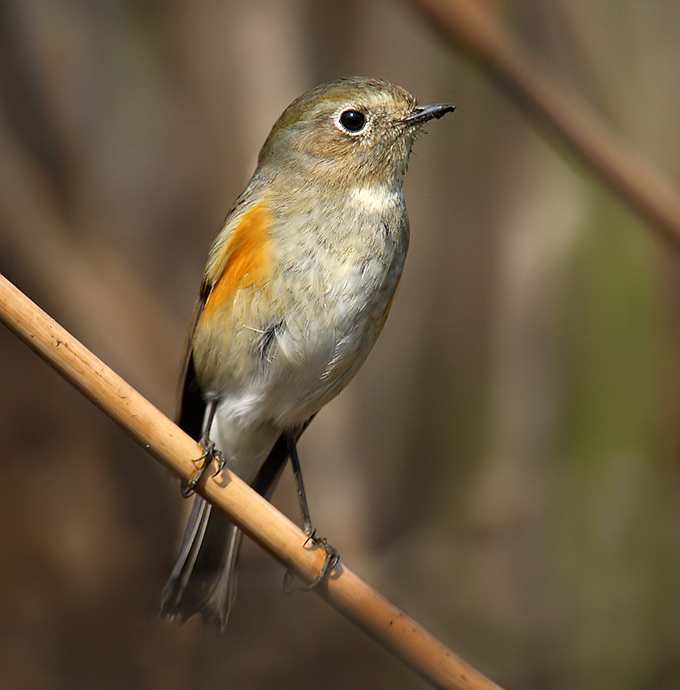
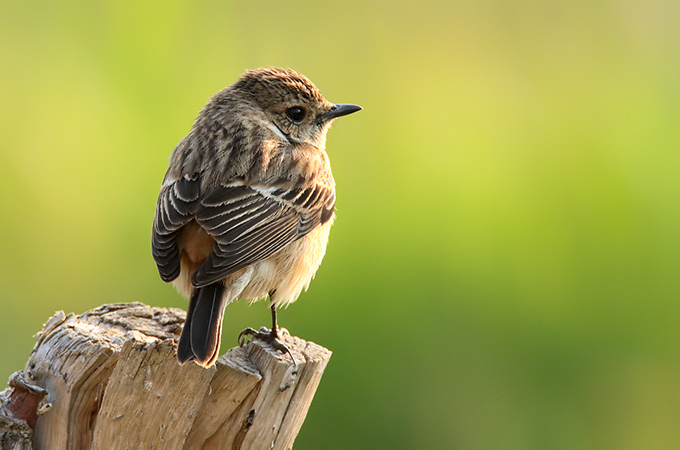
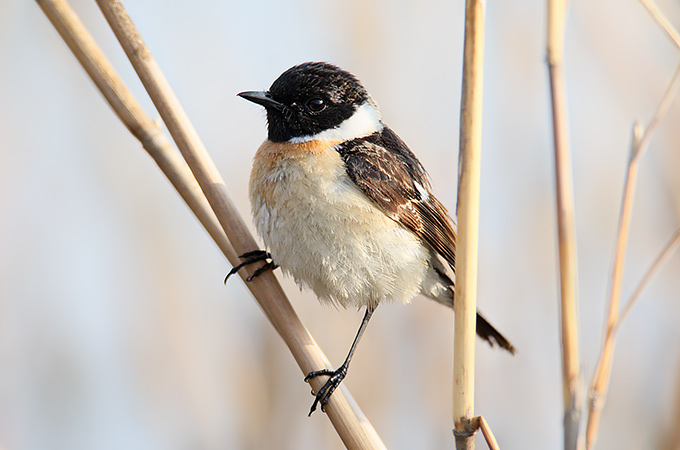
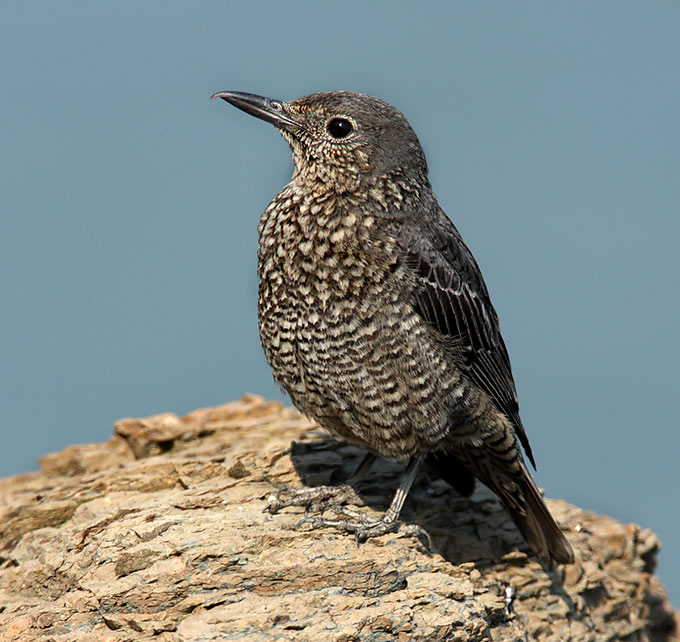
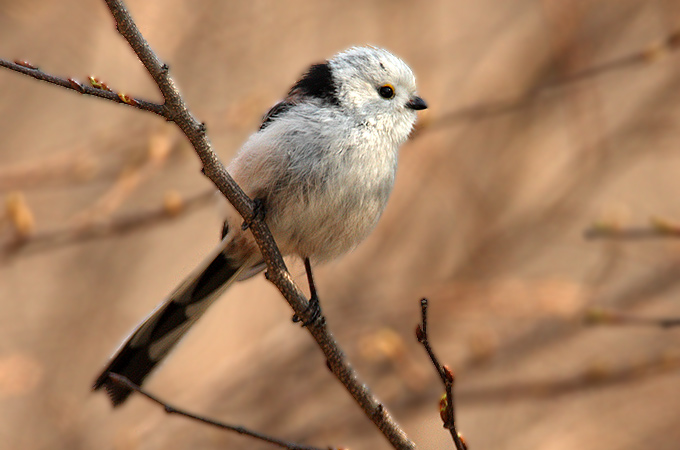
Eocheong, April 9
In very warm sunshine and light winds, 49 species logged in total. Most numerous species included Red-flanked Bluetail (c. 130), Siberian Stonechat (50), and Yellow-throated (40) and Black-faced Buntings (55). Species of most note included the male Black Redstart and the Greater Short-toed Lark still, two Red-billed Starling, and an Ochre-rumped Bunting (perhaps the first record for Eocheong?). In addition, the day also included the spring’s personal first Oriental Scops Owl (3 heard), Eastern Crowned Warbler and Siberian Blue Robin.
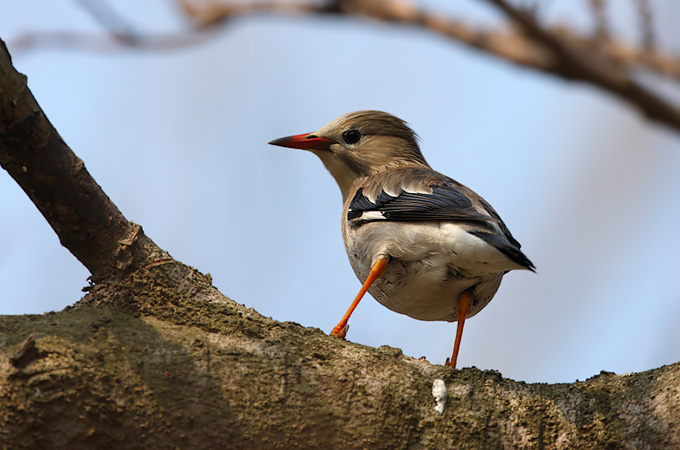
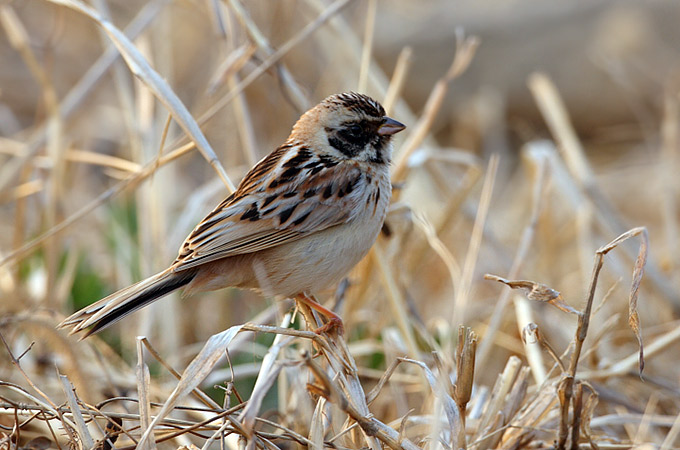
Eocheong, April 8
Calm and sunny once again with a high of 17°C and 47 species logged during the day. The male Black Redstart was relocated, now in the arable plots in “central valley”, where there was also a Red-billed Starling. While the personal first Blue-and-white Flycatcher of the spring was seen at the quarry, the outstanding highlight was found at the lighthouse: a personata White Wagtail. Apparently flying in off the sea, the bird remained for probably less than three minutes, just time to take some record shots. Suspecting that this was the first national record of this highly attractive subspecies, a phone-call revealed that this was rather the second record: Korea’s first personata was actually found the day before, on the southwest island!

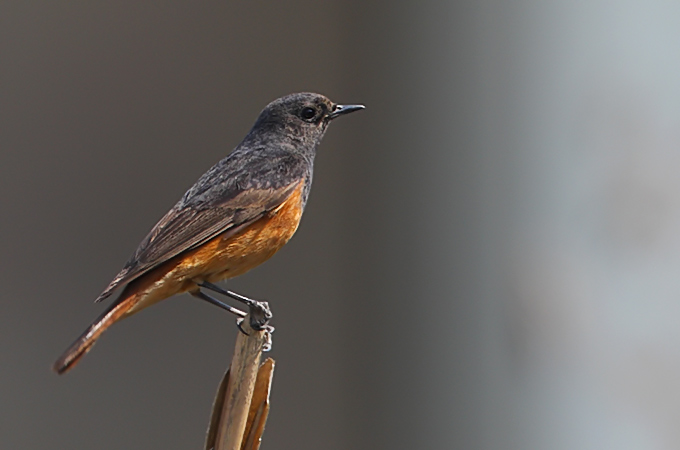

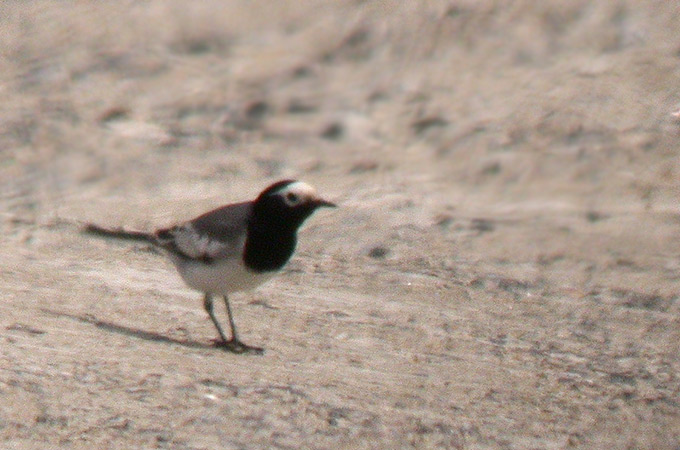
Songdo, April 8
With the mudflat inundated by late afternoon, several seasonal firsts appeared on the lagoon and the increasingly destroyed dustbowl of the former brackish area: a Spotted Redshank, 3 Common Greenshank, 1 Black-tailed Godwit, 2 Chinese Penduline Tit, 135 Great Knot, and an early Whimbrel.
Of 75 Bar-tailed Godwit, two were leg-flagged on the right tibia (one orange flag, the other yellow). Also present 40 Grey Plover, c.60 "Eastern" Oystercatcher, 8 Black-faced Spoonbill, 40+ Dunlin, 100+ Far Eastern and 4 Eurasian Curlew, with a meagre sprinkling of Kentish & Little Ringed Plovers.
In other news, Mongolian Gull are now tending 7 nests: there are c.10 Common and 1 Ruddy Shelduck still lingering, along with a sinngle Coot and Common Pochard. In trees along the bank, 1 Red-flanked Bluetail, 1 Hawfinch, 10+ Olive-backed Pipit, single Dusky and Naumann's Thrushes, 6 Black-faced Bunting and a Siberian Stonechat. Around 40 Saunders's Gull alighted on the mud as the sea receded. Around 70 Great Cormorant flew at height in their V-formation.
Also at the lagoon, reptilian encounters were of a Slender Racer Coluber spinalis snaking into a rock-pile a few feet away, and a few Red-eared Slider Trachemys scripta elegans hauling up on the bank.
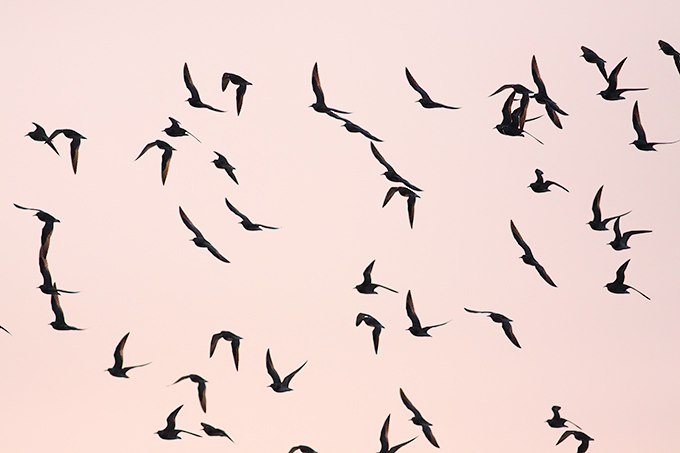
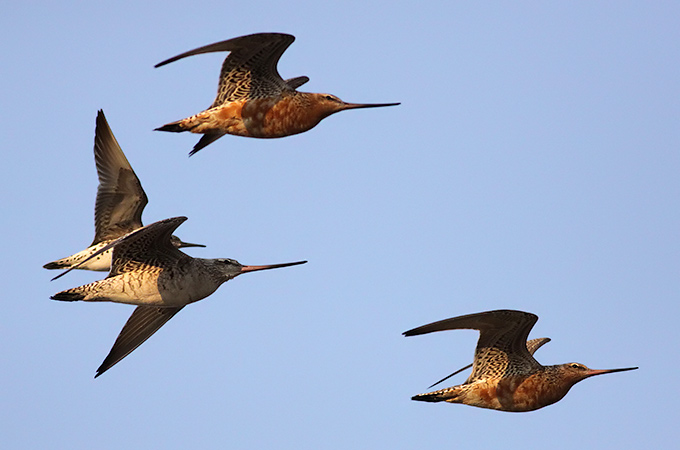
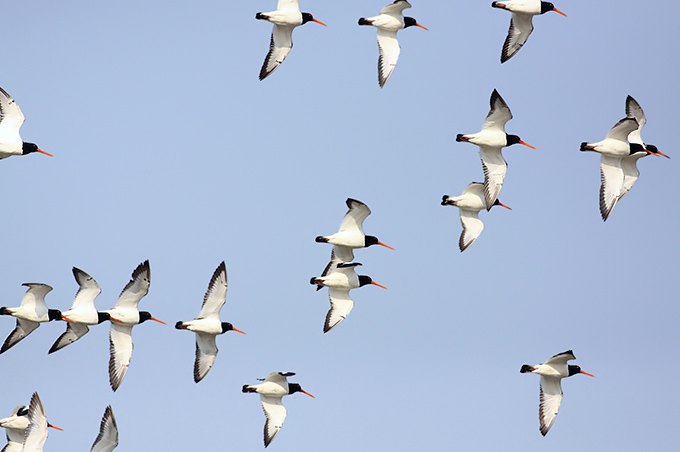
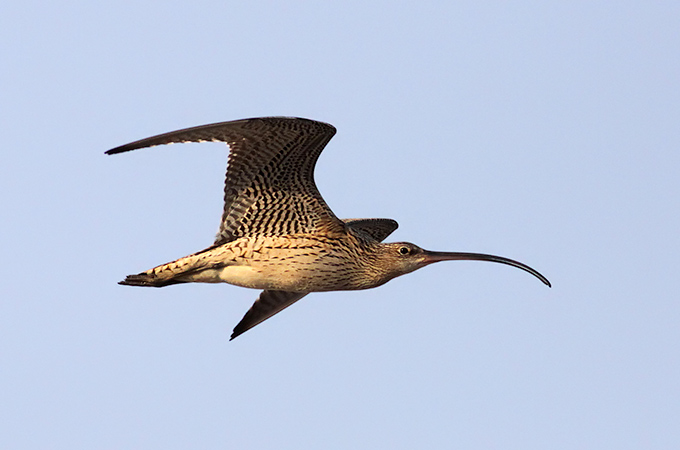
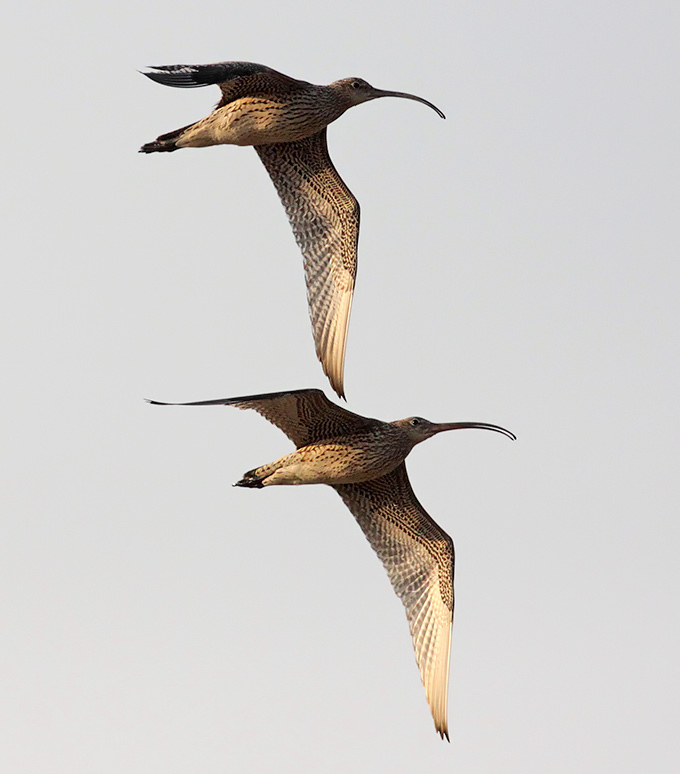
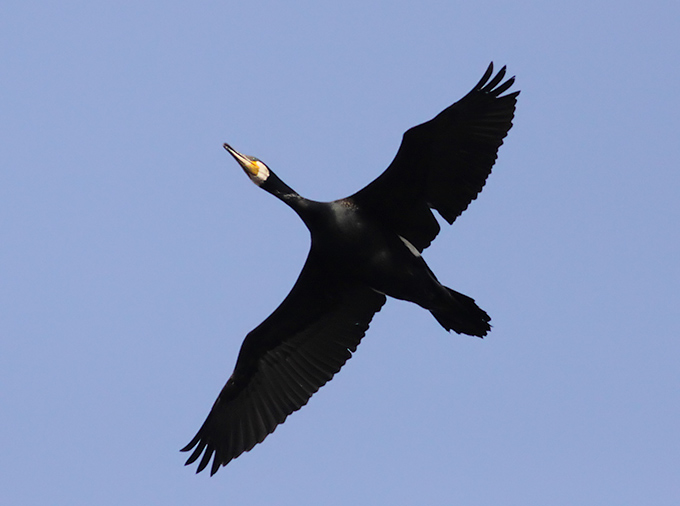
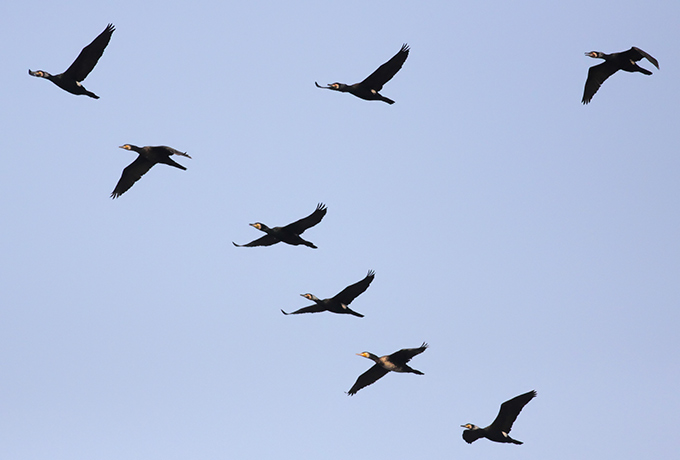
Eocheong, April 7
In calm, warm and sunny conditions, 46 species logged during the afternoon, including a male Black Redstart and the personal first Greater Short-toed Lark of the spring.
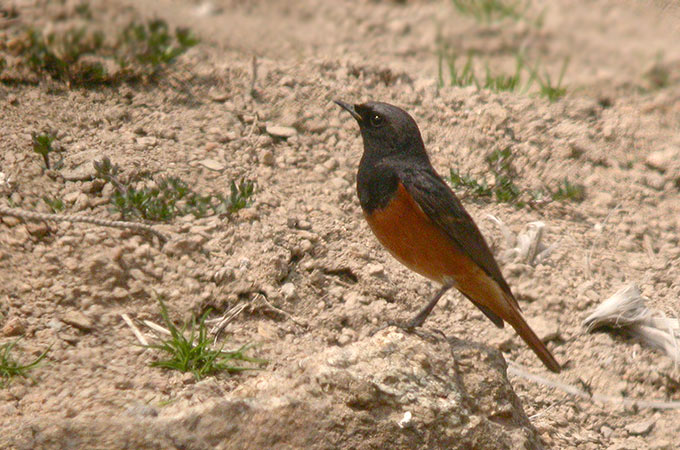
Songdo, April 5
I started out at the lagoon under extreme foggy conditions. This did not prevent me from chalking up good views of 5 Hawfinch, 24 Northern Shoveler, 12 Mongolian Gull (which prevented 5 Black-faced Spoonbill from touching ground) and a personal fist: 1 male Baikal Teal kind of socializing with 46 Common Teal.
The brackish area was void 95% of both avian varieties and water save 2 White Wagtail leucopsis, 1 female Blue Rock Thrush, 1 Common Sandpiper, 5 Little-ringed Plover, 2 Common Stonechat.
he last remaining tidal-flats at Songdo at an afternoon high tide held the following: 2 Garganey, 16 Common Shelduck, 60 Eastern Oystercatcher, 6 Kentish Plover, 1 Grey Plover, and various numbers of Eurasian Curlew, Far-eastern Curlew, Black-tailed Gull, Black-headed Gull, Black-tailed Godwit.
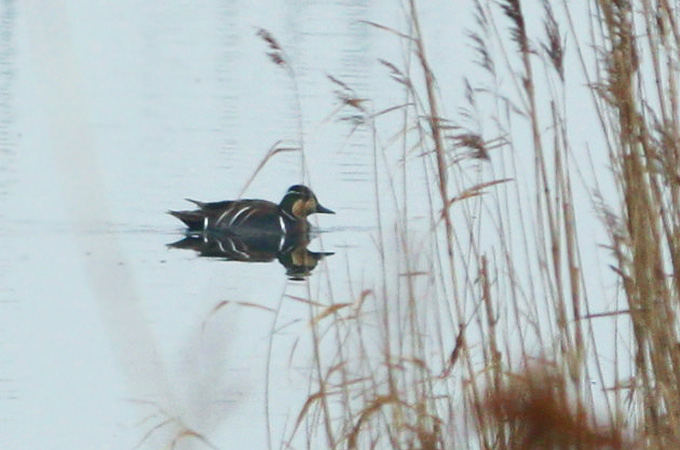
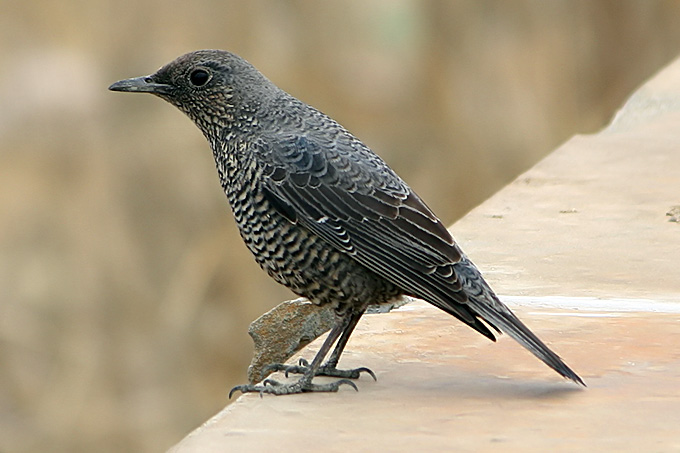

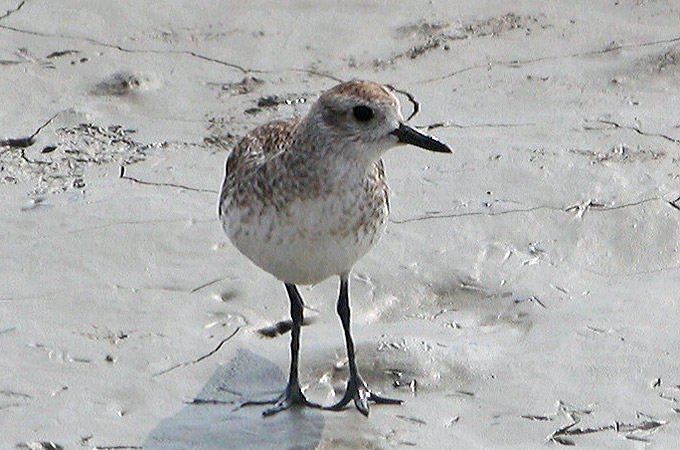
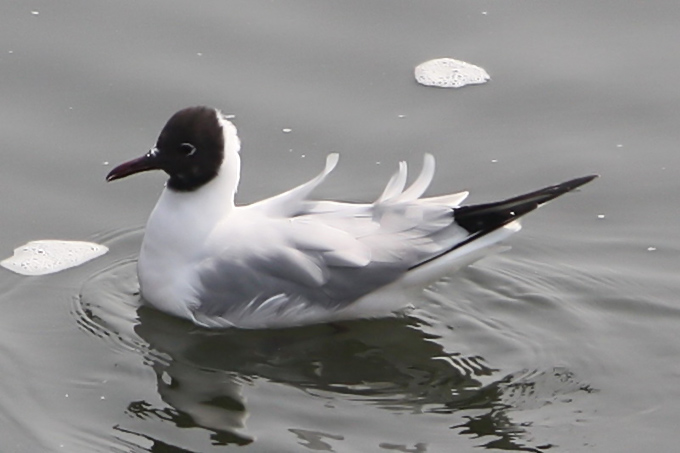
Uiwang, April 5
Most noteworthy at the reservoir today, 2 Common Rosefinch (rare on the mainland) in the wildly overgrown orchard: also 2 very late Baikal Teal drakes dozing in the shade of the willow island.
Spring firsts continued with 2 bathing Barn Swallow, a solitary tired Wood Sandpiper, and 8 gorgeous Garganey in immaculate head-dress. The 5 males squabbled most viciously amongst eachother, while head-popping and bowing to the 3 indifferent females.
Also present, local breeding Mandarin (2), Coot (c.30), Great Crested Grebe (10) and Little Grebe (c.18).Surprisingly persistent winter birds included c.25 Brambling, a Eurasian Sparrowhawk, 2 Pallas's Reed Bunting,6 Dusky Thrush and 25 Gadwall (the males performing slow courtship head-bobbing).
10 -14 Common Snipe included at least one Pintail Snipe, which emitted a distinctly rising, high-pitched squeak when flushed-quite different to the low, harsh "kensch" of Common.
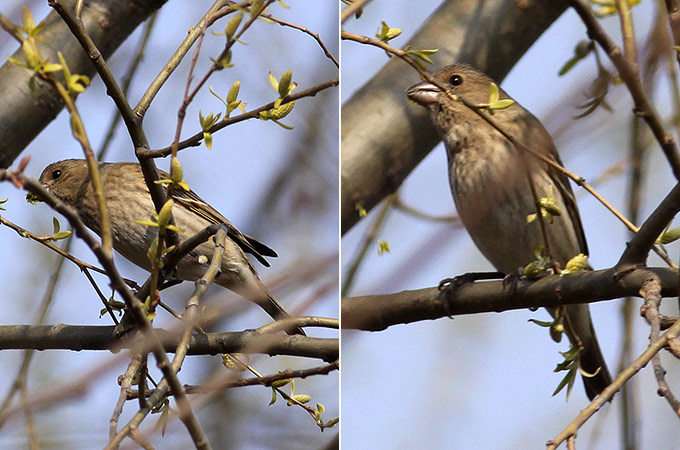
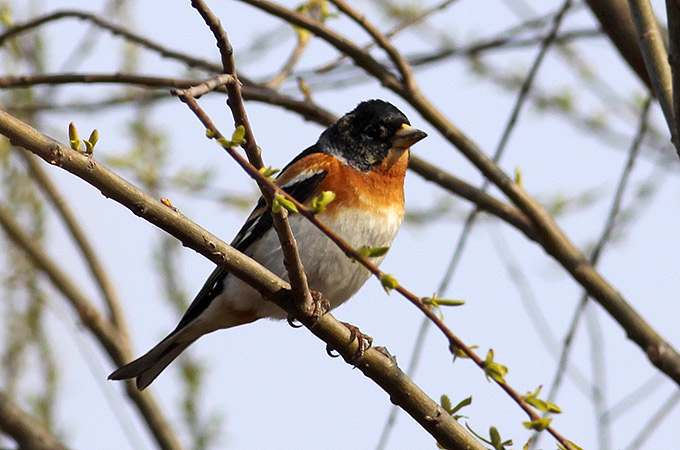
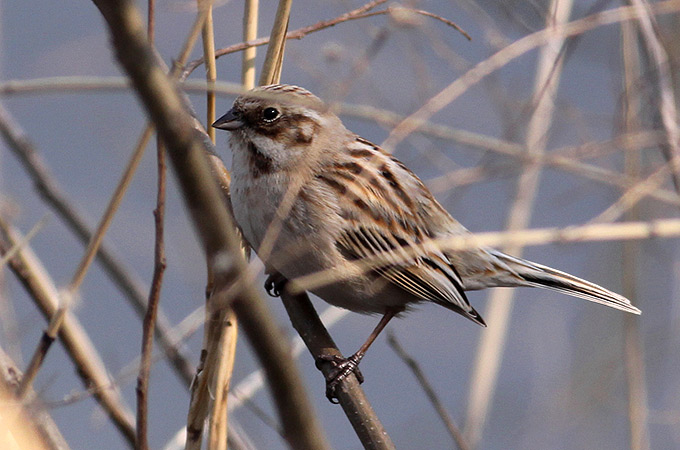
Yongjeong Island, April 4
An interesting mix of birds on Yongjeong, or "Airport island" in fine spring weather, consisting of remnant overwintering species and early spring migrants- best perhaps an Oriental White Stork circling high over the saltpans, loosely interracting with an equally late White-tailed Eagle and Eurasian Sparrowhawk. On the same flats, vocal and restless Little Ringed Plovers are engaging in erratic display flights with brief glides and staggered wingbeats. Also a few leucopsis White Wagtails and a Black-faced Bunting nearby.
On the mudflats in Eulwang bay, 15 Bar-tailed Godwit mingled with c. 200 Far Eastern and 1 Eurasian Curlew, abundant Kentish Plover, 70-80 Dunlin, 7 "Eastern" Oystercatcher, 1 Mandarin and up to 15+ Taimyr Gull. At the nearby swamp,plentiful signs of Korean Water Deer, 2 Siberian Stonechat, 1 Naumann's and 5 Dusky Thrush, c.20 Rustic Bunting and a Common Kingfisher at the stream.
Intense development projects have already transformed much of the islands habitats into concrete, and the especially bird-rich northern reservoir is now being filled in to make way for more warehouses. Here today, surprisingly 3 Temminck's Cormorant (unusual so close to the western mainland), a Black-faced Spoonbill, c.40 Coot, 1 Red-breasted Merganser, around 20 Tufted Duck, 12 Falcated Teal, a Gadwall, singing Far Eastern Larks and 2 Meadow Bunting.
To guard against bird strike in the vicinity of the runway, various actions have been taken recently to clear this area of birds: the local Saunders's Gull colony was today deserted and the site appears to have been marked with ribbons and streamers, presumably to discourage them from nesting. 5 Common Redshank are another local speciality that will soon lose this prime habitat to developers.
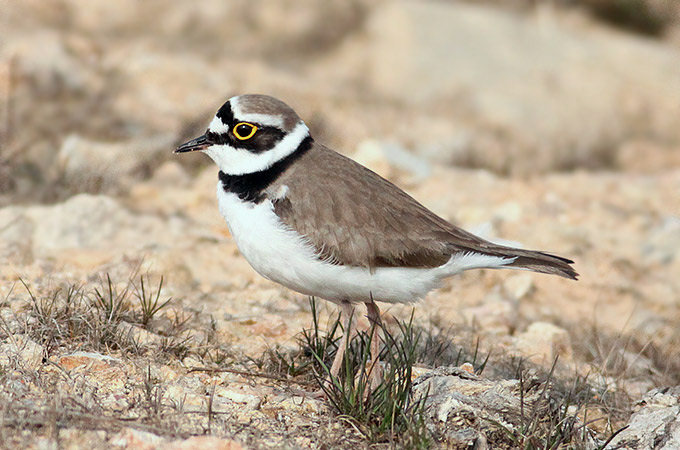
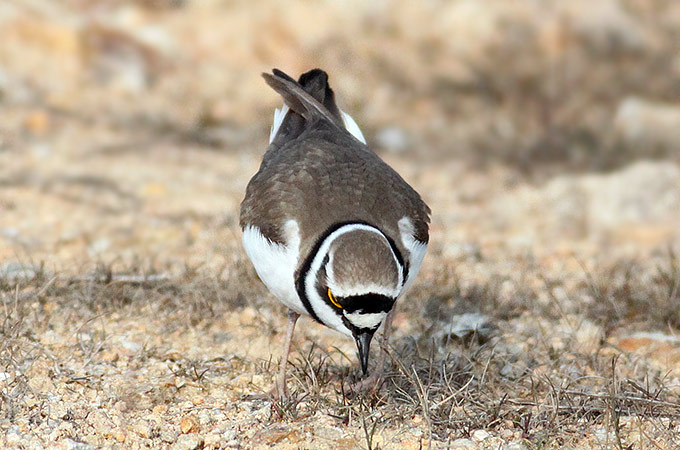
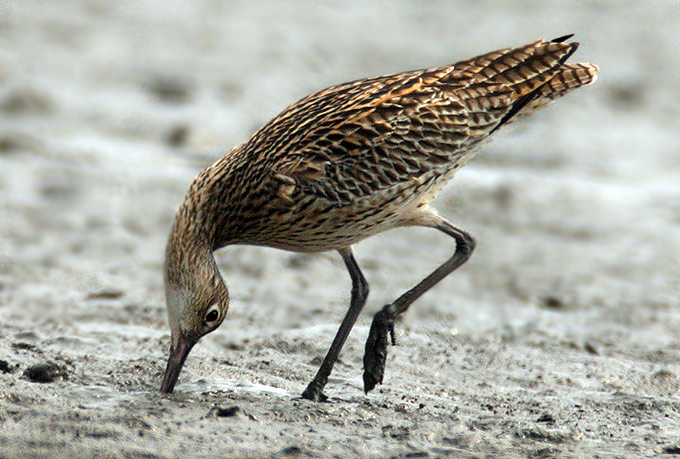
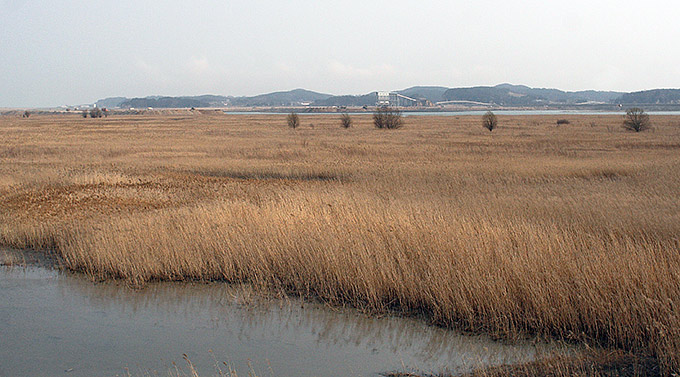
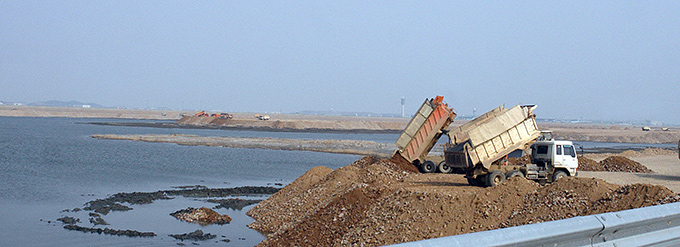
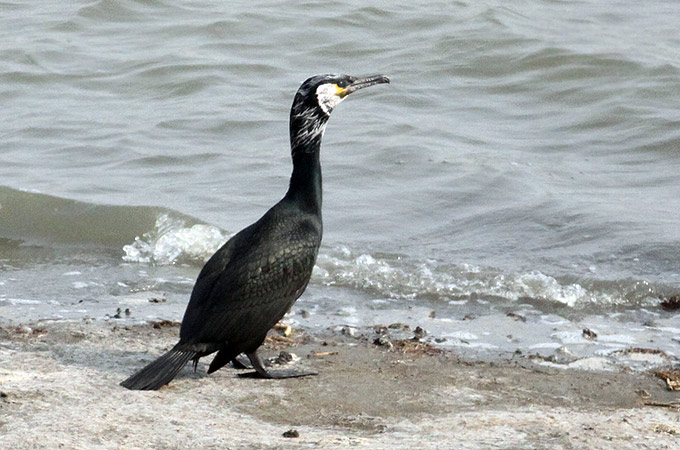
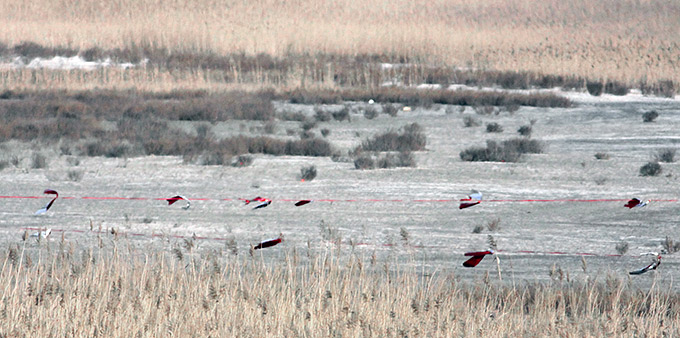
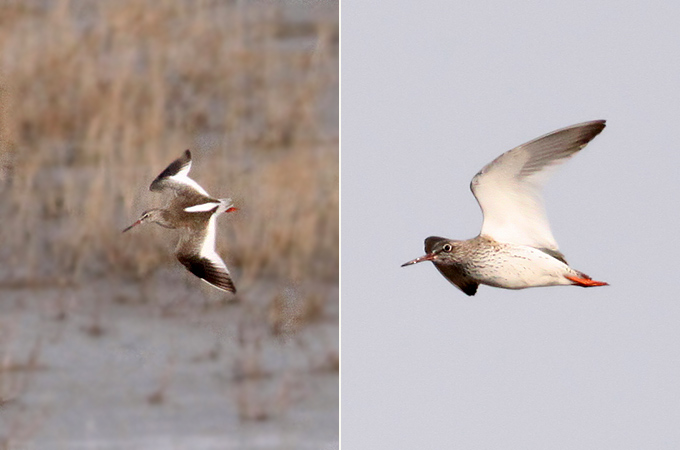
Gageo Island, April 3
With light westerly winds, the start of real spring feeling, with 49 species logged in 1-Gu village/harbor including some winter-lingerers (including half-a-dozen Rustic Bunting, February's Dusky Warbler and a Long-tailed Shrike, back too in its February patch) and increased evidence of movement, biggest of which was a flock of 340 Vega Gull heading purposefully north in the late afternoon (with the lead birds making a clear V formation). Several other species were present in increased numbers, including at least 12 taimyrensis Taimyr Gull, 60 Yellow-throated and 10 Black-faced Buntings and 20 Dusky Thrush. Birds of most note included two Ancient Murrelet at sea, the Bar-tailed Godwit still, between 3 and 6 Asian House Martin (and one poorly-seen house martin with a deeply cleft tail which was more likely a Northern House Martin), and the spring's personal first Wryneck and Eastern Yellow Wagtail (interestingly not a taivana - a taxon found overwintering in Korea in recent years).
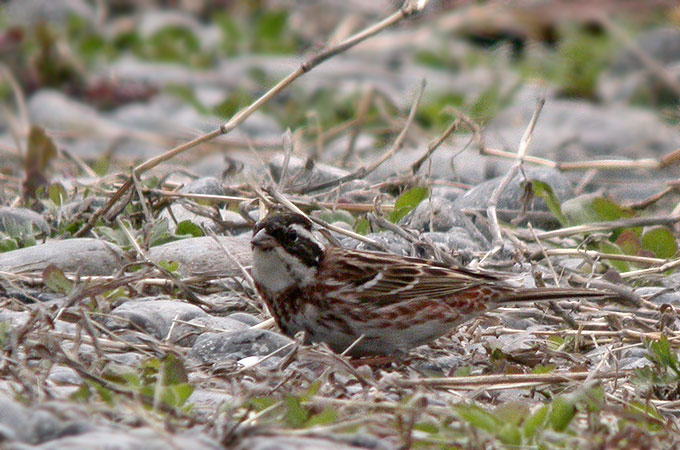
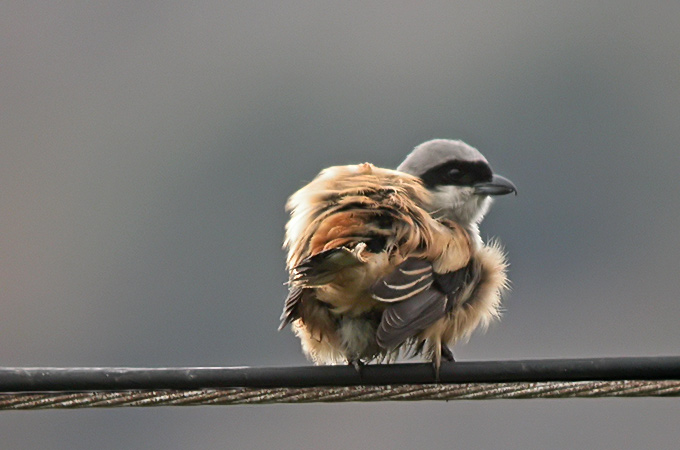
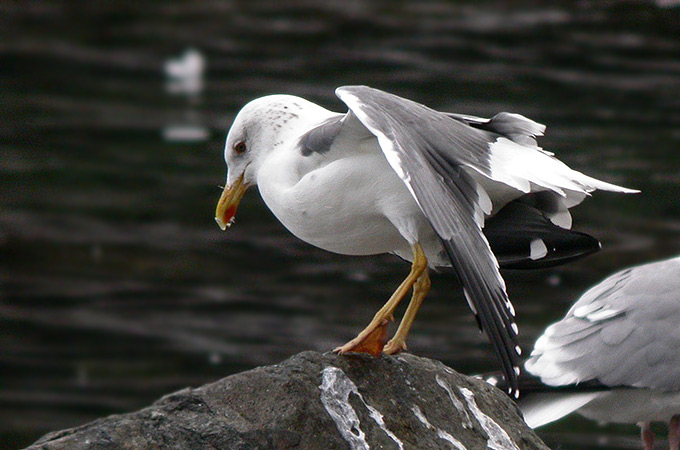
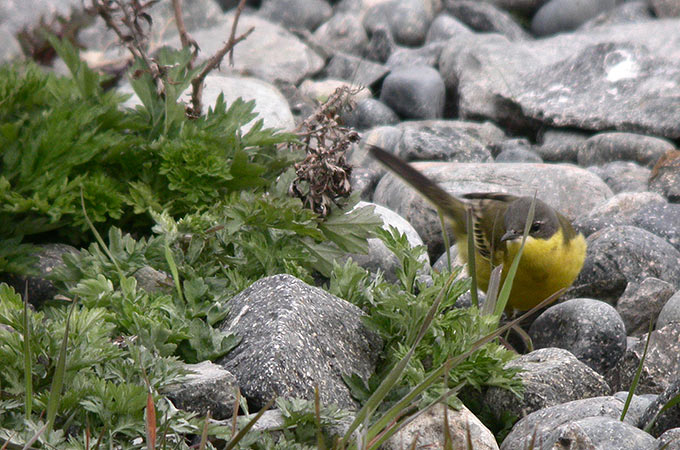
Gageo Island, April 2
In beautiful clear and almost calm conditions, the longest and most gruelling day of Black Woodpigeon survey work so far this year, covering the top of Doksil San (between 400 and 575 m altitude - it certainly feels more like a mountain than a hill!), and then the coast between 3-Gu, the lighthouse and 2-Gu. In 14 or so hours at the north end of the island, a total of c. 40 Black Woodpigeon heard and seen, with several fantastic calls recorded, including the typical crooning, the harder "gravelly" call, the wing-clap display with the full gravelly "GAAAH!" , and a wonderful loon-like lowing: fabulous! Other birds of note included probably the same Grey Bunting heard as last week, a Grey-faced Buzzard, a small and rather dark Northern Goshawk (fujimayae?), the island's first Eurasian Kestrel of the spring, several singing White's and Pale Thrushes in the evening, and what appeared to be a single singing Brown-headed Thrush.
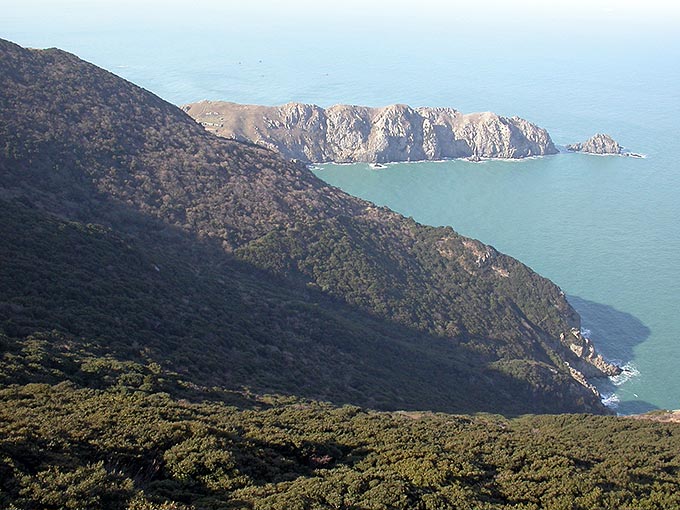
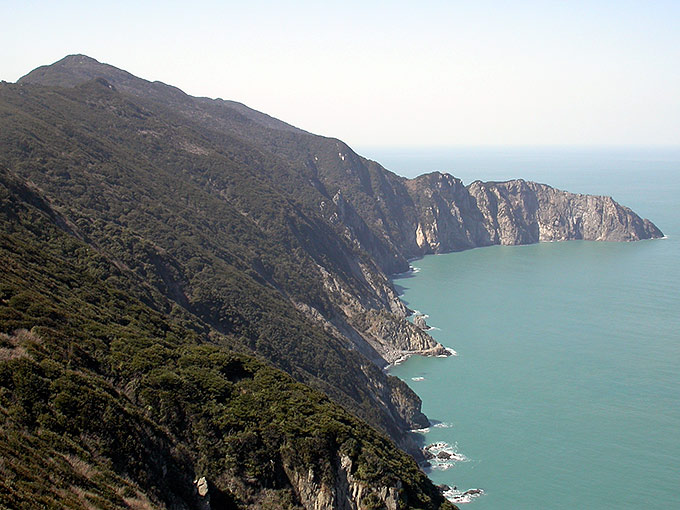
Samyookdae, April 2
An afternoon trip to Samyook’s woods in northeastern Seoul and a scattering of the expected species: one Naumann’s Thrush with a malformed (or rather overgrown), Crossbill-like bill, a single Hawfinch, a Wren, single Japanese Pygmy, Greater Spotted and a White-backed Woodpecker which in one photo appears to be felling the tree, several Goldcrests, Varied and Great Tits, a few Rustic and Yellow-browed Buntings and a muddy-nosed Chipmunk.
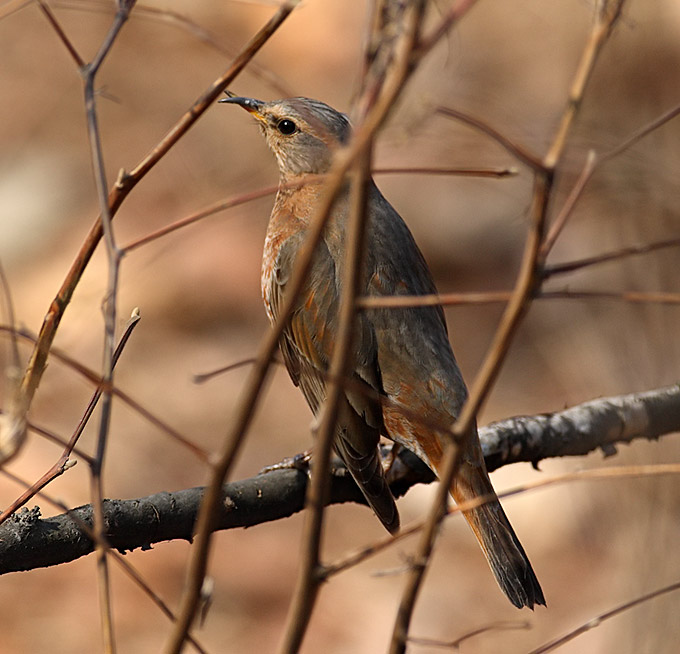
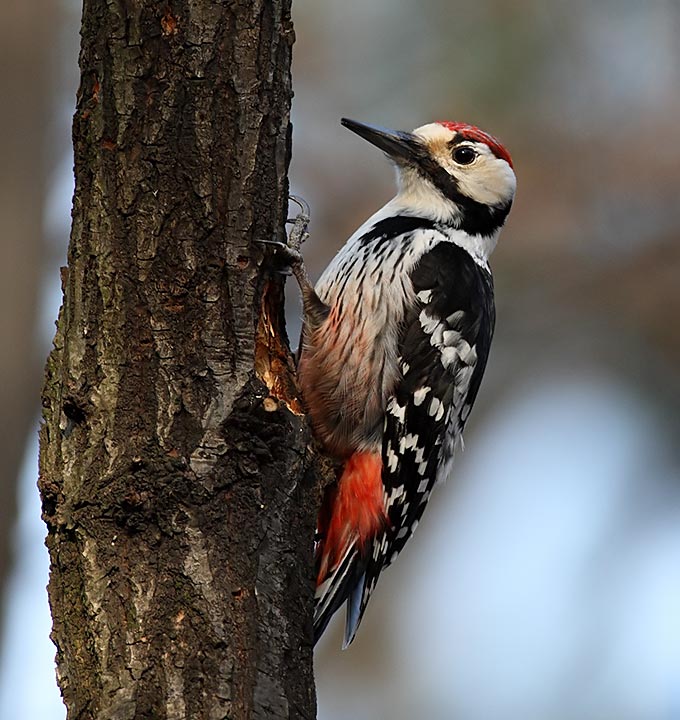
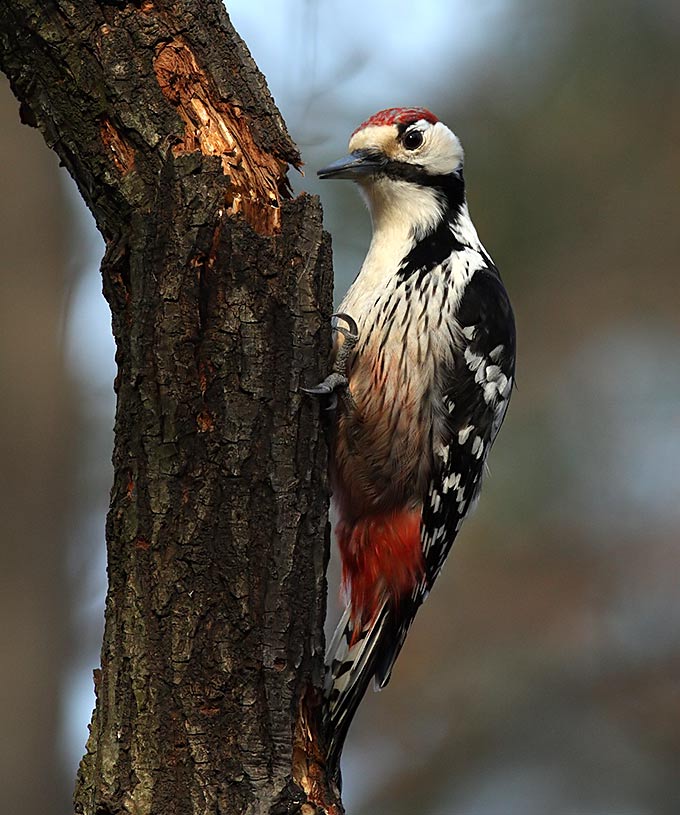
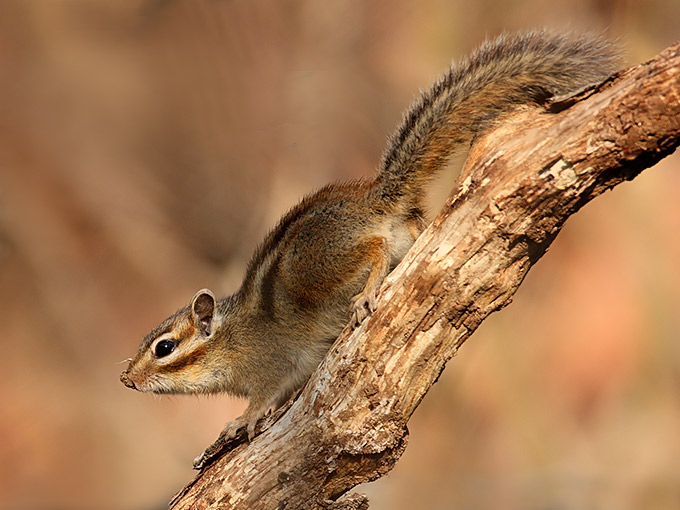
Gageo Island, April 1
With clear skies but a force 6 northerly winds (gusting stronger), only 1-Gu was surveyed. Still no real sign of the first major rush of spring migrants. Around the village, a few more hirundines (with 15 or so Barn Swallow, a Red-rumped Swallow and an Asian House Martin, which looked much dingier below than yesterday's individual), 18 or so Siberian Stonechat, a dozen or so Dusky and half-a-dozen Naumann's, and the island's first Bar-tailed Godwit of the spring, probing the cracks between concrete slabs in the harbor. Further birds of note include an Intermediate Egret and a Common Snipe in "the stream", a Pacific loon resting up on the beach, and at least 3 Mandarin Duck standing on the massive concrete tetrapods at the entrance of the harbor.

